

Book Review Writing Examples
Examples: learn from the efforts of others.
Learning how to write strong reviews takes time and not a little effort. Reading the reviews others have done can help you get a feel for the flow and flavor of reviews.
If I Never Forever Endeavor Review by Hayden, age 4, Southeast Michigan Mensa

This book was about a bird who didn't yet know how to fly.
The bird has to decide if it will try to fly, but it was not sure if it wants to. The bird thought, "If I never forever endeavor" then I won't ever learn. On one wing, he worries he might fail and on the other wing he thinks of how he may succeed. He worries that if he tries, he may get lost in the world. That makes him want to stay in his nest where he's safe.
I think this book would help other children to learn that trying new things can be scary, but sometimes when we try, we can find things that make us happy too. And this book will help others know that mistakes are okay and part of learning.
My favorite part is that the bird tried and learned that she could fly. I also liked that I read this book because it gave me a chance to talk to mom about making mistakes and how I don't like making them. Then I learned they are good and part of learning.
Boys and girls who are 3 to 8 years old would like this book because it teaches about trying a new thing and how it's important to get past being scared so you can learn new things.
I give the book 5 stars since I think it's important for other children to learn about courage.
Flesh & Blood So Cheap Review by Umar B., age 8, Central New Jersy Mensa

I liked this book. People who are interested in national disasters and US history as well as immigration will most probably be interested in reading this book.
Readers can gain knowledge of what it was like to work in New York City in the early 1900s. One of the things that was especially interesting was that there were no safety laws at work. Also, there was a big contrast between the rich and the poor. Some people may not like this book because it is very depressing, but it is an important event in history to remember.
This book was very well written. It has black and white photos along with descriptions of the photos. These photos give us a better idea of what people's lives were like. This book is suitable for 9-20 year olds.
I give this book 5 stars.
Galaxy Zach: Journey to Juno Review by Young Mensan Connor C., age 6, Boston Mensa

Journey To Juno is the second book of the Galaxy Zack series. It is just as good as the first one. It's awesome!
Zack joins the Sprockets Academy Explorers Club at school. They fly on a special trip to Juno, a new planet no one has ever visited. Zack gets paired up with Seth, the class bully, and that's dreadful but Zack is excited when he finds a huge galaxy gemmite. A gemmite that large had not been found in 100 years! Kids will love this book!
Boys and girls will both like it. It's an easy chapter book with pictures on every page. I love the illustrations. I think ages 6-8 would like this but younger kids would like the story being read to them.
My favorite parts are the galactic blast game (it is similar to baseball except there are robots playing), recess at Zack's school where everything is 3-D holographic images, the rainbow river in a crystal cave on Juno, and the galaxy gemmite that Zack finds on Juno. I also loved when a life-size holographic image of his Earth friend appears in Zack's room because he calls him on a hyperphone. I give this book one hundred stars! There is a "to be continued" at the end so you have to read the next book see what's in store. I can't wait to find out what happens!!!
I Capture the Castle Review by Lauren W., age 17, Mensa in Georgia

Dodie Smith's novel I Capture the Castle is a journey through the mind of a young writer as she attempts to chronicle her daily life. Seventeen-year-old Cassandra Mortmain has recently learned to speed-write, and she decides to work on her writing skills by describing the actions and conversations of those around her.
Cassandra lives in a fourteenth-century English castle with an interesting cast of characters: her beautiful older sister, Rose; her rather unsociable author father and his second wife, artist-model Topaz; Stephen, the garden boy; a cat and a bull terrier; and sometimes her brother Thomas when he is home from school. One fateful day they make the acquaintance of the Cotton family, including the two sons, and a web of tangled relationships ensues.
While I definitely recommend this book to other readers, I would recommend it to older teenagers, mainly because it will resonate better with them. The writing is tame enough that younger teens could also read it, but most of the characters are adults or on the verge of adulthood. Older readers would take the most from it since they can not only relate, but they may also better pick up on and appreciate Cassandra's sometimes subtle humor.
Over the course of the novel, Cassandra undergoes a definite transformation from child to mature young adult, even though it's only over the course of several months. I love that I could see into her mindset and read exactly what she was feeling when she thought out situations. Her thoughts flowed well and moved the book along very quickly.
Cassandra's narrative voice is wonderful. She is serious at times, but also very witty, which makes for an engaging read. It feels absolutely real, as though I'm reading someone's actual journal. Sometimes I forget that I am reading a story and not a real-life account. Her emotions and the dialogue are so genuine, and they are spot-on for a seventeen-year-old girl in her situation.
Cassandra has many wonderful insights on life, on topics ranging from writing to faith to matters of the heart. I personally have had some of the same thoughts as Cassandra, except Ms. Smith was able to put them into words.
Capture the Castle should be essential reading for aspiring writers, those looking for historical fiction or romance, or anyone who loves reading amazing classic books. Dodie Smith is an exceptional writer, and I Capture the Castle is a book that will never become obsolete.
Frankenstein's Cat Review by Zander H., age 12, Mid-America Mensa

I appreciated Frankenstein's Cat for its fascinating explanation about the often baffling subject of bioengineering and its sister sciences. Emily Anthes explains the many sides of today's modern technology, such as gene modification, cloning, pharmaceutical products (from the farm), prosthesis, animal tag and tracking and gene cryogenics. This book provides a well-rounded summary of these complicated sciences without being boring or simply factual. Her real world examples take us on a journey from the farm, to the pet store and then from the pharmacy to the frozen arc.
Have you ever wondered if the neighborhood cat is spying on you? Read about Operation Acoustic Kitty and find out if this feline fantasy fiction or fact. Do you think bugs are creepy? What about a zombified cyborg beetle? Is Fido so special that you want two of him? Money can buy you an almost exact copy of your pooch BUT don't expect the same personality. Emily Anthes makes you crave more information. She makes you want to know the future of Earth's flora and fauna, as well as humanity itself.
I would highly recommend this book to anyone who desires a guide to the future of biological science and technology. Frankenstein's Cat is best read by the light of a glow-in-the-dark fish, while cuddling your favorite cloned dog and drinking a glass of genetically modified milk.
About Marsupials Review by Connor C., age 6, Boston Mensa

About Marsupials is the title so the book is about...marsupials, of course. It's non-fiction. I really think everyone would like the book. I think someone who likes animals would especially like to read it.
The glossary of facts in the back of About Marsupials is the most useful part. I thought the most interesting parts were that some marsupials have their pouch at their back legs and one marsupial, the Yellow-footed Rock Wallaby, is very small but can jump 13 feet wide!
Kids in the 4-8 age range would like this book. Even though it's not a story book, 4 year olds would like the few words on each page and they would love the beautiful pictures. But older kids would like it because of all the facts in the back of the book. There's a lot of information for each animal. I think boys and girls (and parents) would enjoy reading it. This book is very interesting. I give it 4 stars.
Mapping the World Review by Umar A., age 10, Central New Jersey Mensa

Every day, people around the world use maps. Whether it is an airplane pilot or businessman, housewife or museum group, maps have always and will continue to provide useful information for all.
Mapping the World talks about the uses of maps, as well as how to differentiate between the type of map projection and type of map.
In this series, we travel to the past and learn about historical mapmakers, from Claudius Ptolemy (who stated the idea that the Earth is at the center of the universe) to Gerardus Mercator (who created one of the most widely used map projections) and more. This series goes into tremendous detail on the cartographer's life and maps. We then journey to the present era to learn about map projections and the diverse types of maps used today. You might ask, "What is the difference between the two? They sound the same to me." No map projection is perfect, because you cannot really flatten a sphere into a rectangle. An uncolored projection could be used in many ways. We could use it for population concentration, highways, land elevation, and so many other things!
For example, we could make a topographic map of the U.S., which shows land elevation. We could make it a colorful map that shows the amount of pollution in different areas, or it could be a population map, or it could even be a map that shows the 50 states, their capitals and borders! Our last step in this amazing excursion is the near future, where we see some hypothetical solutions as to what maps will be used for. Currently, we are working on better virtual map technology.
Now, scientists have been able to put maps on phones. Back in the early 1900s, people had to lug a lot of maps around to find your way from place to place, or just keep asking for directions. Now, all the information is on a phone or global positioning system (GPS). It is amazing how much maps have changed technology and the world in this century.
The Mapping the World 8-book set goes into amazing levels of detail. It is a long read, but it gives an immense range and amount of information that you would not find in any other book or series on maps. The flowing way the chapters and books are organized makes it easy to link passages from different books in this series together. Mapping the World is a treasure box, filled with the seeds of cartography. Collect and plant them, and you soon will have the fruits of cartography, beneficial to those who want to be cartographers. Use this series to the utmost, then the fruits of mapping will be sweet for all who endeavor to succeed in cartography.
This series of lessons was designed to meet the needs of gifted children for extension beyond the standard curriculum with the greatest ease of use for the educator. The lessons may be given to the students for individual self-guided work, or they may be taught in a classroom or a home-school setting. Assessment strategies and rubrics are included at the end of each section. The rubrics often include a column for "scholar points," which are invitations for students to extend their efforts beyond that which is required, incorporating creativity or higher level technical skills.
Book Review Writing
Book Review Examples
Book Review Examples to Help You Get Started

People also read
How to Write a Book Review - A Step By Step Guide
A Complete Book Review Format Guide For Students
Are you in desperate need of some assistance to up your book review writing game?
We know that penning down a review can come off as a tricky challenge, but do not worry!
To help you write book reviews that carry the essence of the book and engage readers, we have collected a handful of book review examples in this blog.
The included examples will enable you to understand different writing styles and approaches taken toward book review writing . So, you can use your words effectively to craft the perfect book review.
Let’s kickstart things off!
- 1. Good Book Review Examples for Students
- 2. Short Book Review Examples for Fiction Books
- 3. Non-Fiction Book Review Examples
Good Book Review Examples for Students
You might be a professional writer, or you may not have any experience in writing book reviews. Rest assured, we’ll show you how to write perfect book reviews with the help of a sample template and great examples.
See this template to know what you should include in your book review:
Book Review Template
Here is a good book review example for 4th-grade students:

Paper Due? Why Suffer? That's our Job!
Book Review Examples for Middle School Students
Reading reviews written by others can help you get a feel and flavor of good book reviews. Learning how to write a perfect book review can help students to:
- Critically analyze a text
- Give a personal opinion on the text
- Improve analyzing and critical thinking skills
Here are some interesting book review examples suitable for middle school students.
Book Review Example for Middle School Students
Book Review Example for Kids
Book Review of Any Book in 300 Words
Science Book Review Example
Book Review Examples For High School Students
Below, you can also find some good book review examples for high school students. These real-life examples can help you get a clear understanding of the standard book review format that you should follow.
Book Review Example for High School Students
Book Review Examples for Class 9
Book Review Example for Grade 10
Book Review Examples for College Students
As a college student, you are required to demonstrate that you have examined the book from different angles. The points you raise in your book review need to be supported with clear facts and evidence.
The following are some interesting critical book review examples for college students to learn how to write a perfect review.
Book Review Example for Class 12
Short Book Review for Students
Conclusion of Book Review Example
Short Book Review Examples for Fiction Books
Fiction book reviews follow the same basic formula as writing book reviews of any other genre. For your help, we have compiled exciting examples of fiction book reviews that you can get valuable assistance from.
Short Book Review Example for Fiction Books
Book Review of Hazel Wood by Melissa Albert
“The Hazel Wood” by Melissa Albert is a work of fiction and falls into fantasy and young adult fiction genres. The novel revolves around fantastical fairy tales, and magical realism, blurring the lines between reality and fantasy.
Here is an example of a comprehensive review of the book Hazel Wood:
Tough Essay Due? Hire Tough Writers!
Non-Fiction Book Review Examples
For reviewing a non-fiction book, you are required to describe the book and summarize major points of interest. You should evaluate the author’s contribution to a subject that you may know very little about.
Here is a great non-fiction book review example to help you come up with a critical perspective on a text.
Non-Fiction Book Review Example
Hopefully, with the help of the above examples, you get a better idea of how to write a perfect book review.
To wrap it up, Writing a great book review is a tricky task, no matter if you are a high school, college, or university student. Book review writing might seem like a simple task, but it requires excellent analyzing and critical thinking skills.
But, not everyone can crack this task easily. They might need additional help from expert book review writers. That’s why our professional essay writing service offers book review writing help whenever you need it.
Professional essay writers at MyPerfectWords.com can help you with all your academic requests within your specified timeline. Just contact our customer service and we’ll handle all your queries promptly.
Keep the words flowing!

Write Essay Within 60 Seconds!

Cathy has been been working as an author on our platform for over five years now. She has a Masters degree in mass communication and is well-versed in the art of writing. Cathy is a professional who takes her work seriously and is widely appreciated by clients for her excellent writing skills.

Paper Due? Why Suffer? That’s our Job!
Keep reading


How to Write a Book Review: The Ultimate Guide
WHAT IS A BOOK REVIEW?

Traditionally, book reviews are evaluations of a recently published book in any genre. Usually, around the 500 to 700-word mark, they briefly describe a text’s main elements while appraising the work’s strengths and weaknesses. Published book reviews can appear in newspapers, magazines, and academic journals. They provide the reader with an overview of the book itself and indicate whether or not the reviewer would recommend the book to the reader.
WHAT IS THE PURPOSE OF A BOOK REVIEW?
There was a time when book reviews were a regular appearance in every quality newspaper and many periodicals. They were essential elements in whether or not a book would sell well. A review from a heavyweight critic could often be the deciding factor in whether a book became a bestseller or a damp squib. In the last few decades, however, the book review’s influence has waned considerably, with many potential book buyers preferring to consult customer reviews on Amazon, or sites like Goodreads, before buying. As a result, book review’s appearance in newspapers, journals, and digital media has become less frequent.
WHY BOTHER TEACHING STUDENTS TO WRITE BOOK REVIEWS AT ALL?
Even in the heyday of the book review’s influence, few students who learned the craft of writing a book review became literary critics! The real value of crafting a well-written book review for a student does not lie in their ability to impact book sales. Understanding how to produce a well-written book review helps students to:
● Engage critically with a text
● Critically evaluate a text
● Respond personally to a range of different writing genres
● Improve their own reading, writing, and thinking skills.
Not to Be Confused with a Book Report!
WHAT’S THE DIFFERENCE BETWEEN A BOOK REVIEW AND A BOOK REPORT?

While the terms are often used interchangeably, there are clear differences in both the purpose and the format of the two genres. Generally speaking, book reports aim to give a more detailed outline of what occurs in a book. A book report on a work of fiction will tend to give a comprehensive account of the characters, major plot lines, and themes in the book. Book reports are usually written around the K-12 age range, while book reviews tend not to be undertaken by those at the younger end of this age range due to the need for the higher-level critical skills required in writing them. At their highest expression, book reviews are written at the college level and by professional critics.
Learn how to write a book review step by step with our complete guide for students and teachers by familiarizing yourself with the structure and features.
BOOK REVIEW STRUCTURE
ANALYZE Evaluate the book with a critical mind.
THOROUGHNESS The whole is greater than the sum of all its parts. Review the book as a WHOLE.
COMPARE Where appropriate compare to similar texts and genres.
THUMBS UP OR DOWN? You are going to have to inevitably recommend or reject this book to potential readers.
BE CONSISTENT Take a stance and stick with it throughout your review.
FEATURES OF A BOOK REVIEW
PAST TENSE You are writing about a book you have already read.
EMOTIVE LANGUAGE Whatever your stance or opinion be passionate about it. Your audience will thank you for it.
VOICE Both active and passive voice are used in recounts.
A COMPLETE UNIT ON REVIEW AND ANALYSIS OF TEXTS

⭐ Make MOVIES A MEANINGFUL PART OF YOUR CURRICULUM with this engaging collection of tasks and tools your students will love. ⭐ All the hard work is done for you with NO PREPARATION REQUIRED.
This collection of 21 INDEPENDENT TASKS and GRAPHIC ORGANIZERS takes students beyond the hype, special effects and trailers to look at visual literacy from several perspectives offering DEEP LEARNING OPPORTUNITIES by watching a SERIES, DOCUMENTARY, FILM, and even VIDEO GAMES.
ELEMENTS OF A BOOK REVIEW
As with any of the writing genres we teach our students, a book review can be helpfully explained in terms of criteria. While there is much to the ‘art’ of writing, there is also, thankfully, a lot of the nuts and bolts that can be listed too. Have students consider the following elements before writing:
● Title: Often, the title of the book review will correspond to the title of the text itself, but there may also be some examination of the title’s relevance. How does it fit into the purpose of the work as a whole? Does it convey a message or reveal larger themes explored within the work?
● Author: Within the book review, there may be some discussion of who the author is and what they have written before, especially if it relates to the current work being reviewed. There may be some mention of the author’s style and what they are best known for. If the author has received any awards or prizes, this may also be mentioned within the body of the review.
● Genre: A book review will identify the genre that the book belongs to, whether fiction or nonfiction, poetry, romance, science-fiction, history etc. The genre will likely tie in, too with who the intended audience for the book is and what the overall purpose of the work is.
● Book Jacket / Cover: Often, a book’s cover will contain artwork that is worthy of comment. It may contain interesting details related to the text that contribute to, or detract from, the work as a whole.
● Structure: The book’s structure will often be heavily informed by its genre. Have students examine how the book is organized before writing their review. Does it contain a preface from a guest editor, for example? Is it written in sections or chapters? Does it have a table of contents, index, glossary etc.? While all these details may not make it into the review itself, looking at how the book is structured may reveal some interesting aspects.
● Publisher and Price: A book review will usually contain details of who publishes the book and its cost. A review will often provide details of where the book is available too.

BOOK REVIEW KEY ELEMENTS
As students read and engage with the work they will review, they will develop a sense of the shape their review will take. This will begin with the summary. Encourage students to take notes during the reading of the work that will help them in writing the summary that will form an essential part of their review. Aspects of the book they may wish to take notes on in a work of fiction may include:
● Characters: Who are the main characters? What are their motivations? Are they convincingly drawn? Or are they empathetic characters?
● Themes: What are the main themes of the work? Are there recurring motifs in the work? Is the exploration of the themes deep or surface only?
● Style: What are the key aspects of the writer’s style? How does it fit into the wider literary world?
● Plot: What is the story’s main catalyst? What happens in the rising action? What are the story’s subplots?
A book review will generally begin with a short summary of the work itself. However, it is important not to give too much away, remind students – no spoilers, please! For nonfiction works, this may be a summary of the main arguments of the work, again, without giving too much detail away. In a work of fiction, a book review will often summarise up to the rising action of the piece without going beyond to reveal too much!

The summary should also provide some orientation for the reader. Given the nature of the purpose of a review, it is important that students’ consider their intended audience in the writing of their review. Readers will most likely not have read the book in question and will require some orientation. This is often achieved through introductions to the main characters, themes, primary arguments etc. This will help the reader to gauge whether or not the book is of interest to them.
Once your student has summarized the work, it is time to ‘review’ in earnest. At this point, the student should begin to detail their own opinion of the book. To do this well they should:
i. Make It Personal
Often when teaching essay writing we will talk to our students about the importance of climbing up and down the ladder of abstraction. Just as it is helpful to explore large, more abstract concepts in an essay by bringing it down to Earth, in a book review, it is important that students can relate the characters, themes, ideas etc to their own lives.
Book reviews are meant to be subjective. They are opinion pieces, and opinions grow out of our experiences of life. Encourage students to link the work they are writing about to their own personal life within the body of the review. By making this personal connection to the work, students contextualize their opinions for the readers and help them to understand whether the book will be of interest to them or not in the process.
ii. Make It Universal
Just as it is important to climb down the ladder of abstraction to show how the work relates to individual life, it is important to climb upwards on the ladder too. Students should endeavor to show how the ideas explored in the book relate to the wider world. The may be in the form of the universality of the underlying themes in a work of fiction or, for example, the international implications for arguments expressed in a work of nonfiction.
iii. Support Opinions with Evidence
A book review is a subjective piece of writing by its very nature. However, just because it is subjective does not mean that opinions do not need to be justified. Make sure students understand how to back up their opinions with various forms of evidence, for example, quotations, statistics, and the use of primary and secondary sources.
EDIT AND REVISE YOUR BOOK REVIEW

As with any writing genre, encourage students to polish things up with review and revision at the end. Encourage them to proofread and check for accurate spelling throughout, with particular attention to the author’s name, character names, publisher etc.
It is good practice too for students to double-check their use of evidence. Are statements supported? Are the statistics used correctly? Are the quotations from the text accurate? Mistakes such as these uncorrected can do great damage to the value of a book review as they can undermine the reader’s confidence in the writer’s judgement.
The discipline of writing book reviews offers students opportunities to develop their writing skills and exercise their critical faculties. Book reviews can be valuable standalone activities or serve as a part of a series of activities engaging with a central text. They can also serve as an effective springboard into later discussion work based on the ideas and issues explored in a particular book. Though the book review does not hold the sway it once did in the mind’s of the reading public, it still serves as an effective teaching tool in our classrooms today.

Teaching Resources
Use our resources and tools to improve your student’s writing skills through proven teaching strategies.
BOOK REVIEW GRAPHIC ORGANIZER (TEMPLATE)

101 DIGITAL & PRINT GRAPHIC ORGANIZERS FOR ALL CURRICULUM AREAS

Introduce your students to 21st-century learning with this GROWING BUNDLE OF 101 EDITABLE & PRINTABLE GRAPHIC ORGANIZERS. ✌ NO PREP REQUIRED!!! ✌ Go paperless, and let your students express their knowledge and creativity through the power of technology and collaboration inside and outside the classroom with ease.
Whilst you don’t have to have a 1:1 or BYOD classroom to benefit from this bundle, it has been purpose-built to deliver through platforms such as ✔ GOOGLE CLASSROOM, ✔ OFFICE 365, ✔ or any CLOUD-BASED LEARNING PLATFORM.
Book and Movie review writing examples (Student Writing Samples)
Below are a collection of student writing samples of book reviews. Click on the image to enlarge and explore them in greater detail. Please take a moment to both read the movie or book review in detail but also the teacher and student guides which highlight some of the key elements of writing a text review
Please understand these student writing samples are not intended to be perfect examples for each age or grade level but a piece of writing for students and teachers to explore together to critically analyze to improve student writing skills and deepen their understanding of book review writing.
We would recommend reading the example either a year above and below, as well as the grade you are currently working with to gain a broader appreciation of this text type .

BOOK REVIEW VIDEO TUTORIALS

OTHER GREAT ARTICLES RELATED TO BOOK REVIEWS

Transactional Writing

How to write a text response

How to Write a Compare and Contrast Essay

How to Write Excellent Expository Essays
Jump to navigation
- Inside Writing
- Teacher's Guides
- Student Models
- Writing Topics
- Minilessons
- Shopping Cart
- Inside Grammar
- Grammar Adventures
- CCSS Correlations
- Infographics
Get a free Grammar Adventure! Choose a single Adventure and add coupon code ADVENTURE during checkout. (All-Adventure licenses aren’t included.)
Sign up or login to use the bookmarking feature.
- 31 Writing Book Reviews
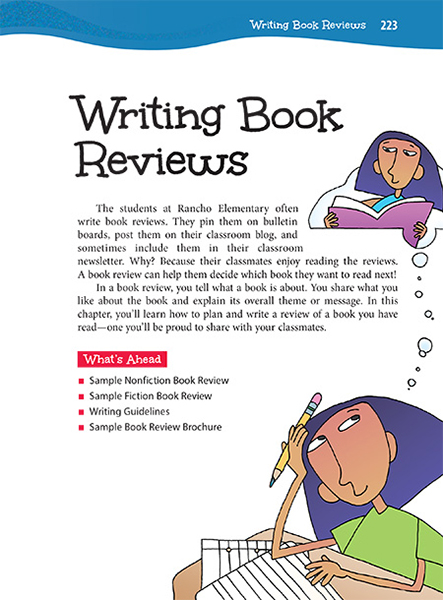
Start-Up Activity
Make a list of your three favorite books. For each book, identify two or three things you like about it. Share your list with your class. Then have your students list their three favorite books and what they liked about each. Point out that these thoughts could be used in a book review. Then ask if there was anything students didn't like about one of the books. Note that a criticism also could be part of a book review.
Think About It
“There are books of which the backs and covers are by far the best parts.”
—Charles Dickens
State Standards Covered in This Chapter
- CCSS.ELA-LITERACY.RI.4.1
- CCSS.ELA-LITERACY.RI.4.2
- CCSS.ELA-LITERACY.RI.4.3
- CCSS.ELA-LITERACY.RI.4.4
- CCSS.ELA-LITERACY.RI.4.5
- CCSS.ELA-LITERACY.RI.4.7
- CCSS.ELA-LITERACY.RI.4.9
- CCSS.ELA-LITERACY.RI.5.1
- CCSS.ELA-LITERACY.RI.5.2
- CCSS.ELA-LITERACY.RI.5.3
- CCSS.ELA-LITERACY.RI.5.4
- CCSS.ELA-LITERACY.RI.5.5
- CCSS.ELA-LITERACY.RI.5.7
- CCSS.ELA-LITERACY.RI.5.9
- CCSS.ELA-LITERACY.RL.4.1
- CCSS.ELA-LITERACY.RL.4.2
- CCSS.ELA-LITERACY.RL.4.3
- CCSS.ELA-LITERACY.RL.4.4
- CCSS.ELA-LITERACY.RL.5.1
- CCSS.ELA-LITERACY.RL.5.2
- CCSS.ELA-LITERACY.RL.5.3
- CCSS.ELA-LITERACY.RL.5.4
- CCSS.ELA-LITERACY.W.4.2
- CCSS.ELA-LITERACY.W.4.4
- CCSS.ELA-LITERACY.W.4.5
- CCSS.ELA-LITERACY.L.4.1
- CCSS.ELA-LITERACY.L.4.2
- CCSS.ELA-LITERACY.W.5.2
- CCSS.ELA-LITERACY.W.5.4
- CCSS.ELA-LITERACY.W.5.5
- CCSS.ELA-LITERACY.L.5.1
- CCSS.ELA-LITERACY.L.5.2
LAFS Covered in This Chapter
Lafs.4.ri.1.1, lafs.4.ri.1.2, lafs.4.ri.1.3, lafs.4.ri.2.4, lafs.4.ri.2.5, lafs.4.ri.3.7, lafs.4.ri.3.9, lafs.5.ri.1.1, lafs.5.ri.1.2, lafs.5.ri.1.3, lafs.5.ri.2.4, lafs.5.ri.2.5, lafs.5.ri.3.7, lafs.5.ri.3.9, lafs.4.rl.1.1, lafs.4.rl.1.2, lafs.4.rl.1.3, lafs.4.rl.2.4, lafs.5.rl.1.1, lafs.5.rl.1.2, lafs.5.rl.1.3, lafs.5.rl.2.4, lafs.4.w.1.2, lafs.4.w.2.4, lafs.4.w.2.5, lafs.4.l.1.1, lafs.4.l.1.2, lafs.5.w.1.2, lafs.5.w.2.4, lafs.5.w.2.5, lafs.5.l.1.1, lafs.5.l.1.2, teks covered in this chapter, 110.6.b.9.d, 110.6.b.9.d.i, 110.6.b.7.c, 110.6.b.7.d, 110.6.b.9.d.iii, 110.6.b.9.d.ii, 110.6.b.9.f, 110.7.b.9.d, 110.7.b.7.d, 110.7.b.9.d.iii, 110.7.b.9.f, 110.6.b.8.a, 110.6.b.8.b, 110.7.b.8.a, 110.7.b.7.c, 110.7.b.8.b, 110.7.b.8.c, 110.7.b.8.d, 110.7.b.10.d, 110.6.b.11.b, 110.6.b.12.b, 110.6.b.11.a, 110.6.b.11.c, 110.6.b.11.d, 110.6.b.1.c, 110.6.b.11.d.ix, 110.6.b.11.d.x, 110.6.b.11.d.xi, 110.7.b.12.b, 110.7.b.11.a, 110.7.b.11.c, 110.7.b.11.d, 110.7.b.1.c, page 224 from writers express, sample nonfiction book review.
Express to your students that reading nonfiction books can broaden their perspective on the people, places, and things that make up our world. Then introduce them to the sample book review on this page. Explain that they will be writing something similar about a nonfiction book they are currently reading or have finished recently.
As you explore the sample, point out its key parts. Explain that the beginning gets the readers’ attention and the middle paragraphs answer key questions about the book.
Related Resource Tags
Click to view a list of tags that tie into other resources on our site
Page 225 from Writers Express
Sample Nonfiction Book Review (Continued)
Have your students read through the remainder of the sample nonfiction book review. Point out the use of the headings in the sample. Explain that they guide readers from section to section in the review. Finally, note how the ending tells why others might enjoy the book but doesn't spoil the book's ending.
Page 226 from Writers Express
Sample fiction book review.
Explain that fiction often presents readers with fascinating characters, interesting settings, and dramatic action. Then introduce them to the sample fiction book review on this page. Explain that they will be writing a similar review about a piece of fiction they are currently reading or have read recently.
Next, examine the key parts of the review as a class. Point out how the beginning hooks readers by sharing an interesting detail about the book. It also introduces the title and the author. Then review how the middle paragraphs answer key questions about the book.
Page 227 from Writers Express
Sample Fiction Book Review (Continued)
Read the remainder of the sample fiction book review with your class. Point out how the headings in the middle part review what's to come next in the review.
Finally, closely analyze the ending paragraph with your students. Point out how it shares an exciting summary of what happens in the book but doesn't spoil the ending. Note how the ending uses a question: How will anything turn out right? This question speaks directly to the reader, as does the closing line.
Page 228 from Writers Express
Writing guidelines.
Walk your students through the process of writing a book review. Encourage them to reserve space in a notebook or note-taking device for answering the four main questions of a book review: What is the book about? What do I like about the book? What is the book's theme or message? Why would others like it? Then move on to the drafting tips. Explain that each question should be answered fully in separate paragraphs.
Next, you can discuss the final steps in the writing process: revising and editing. For revising, point your students to the four questions for "Improving Your Book Review." Students should be able to answer "yes" to each question before moving onto editing. If they cannot answer "yes," encourage them to add the missing details. This may require them to go back to the book they were reading. Finally, to help students understand the kinds of questions they should ask themselves when they edit, you can share with them the Editing Checklist download.
Page 229 from Writers Express
Collection sheet.
You can use the questions on this page to guide your students' prewriting and revising. Make sure to point out that fiction and nonfiction book reviews require different answers to these questions, as noted on this page. Download and distribute the book review collection sheet to help students gather details.
Encourage your students to check this page regularly as they read and write. While reading, they can search for and take notes of answers to the specific questions. While writing, they can use the page as a checklist of key questions to answer in their reviews.
Sharing Fiction with a Partner
Use shared inquiry to read fiction.

Page 230 from Writers Express
Sample book review brochure.
If you're looking for an alternative assignment to a standard book review, you could have your students create book review brochures. This page features one example. Show your students that the inside pages of the sample brochure answer the key questions from the previous page, only in bite-size pieces.
- 01 A Basic Writing Guide
- 02 Understanding the Writing Process
- 03 One Writer's Process
- 04 Qualities of Writing
- 05 Selecting and Collecting
- 06 Focusing and Organizing
- 07 Writing and Revising
- 09 Publishing
- 10 Writing Basic Sentences
- 11 Combining Sentences
- 12 Writing Paragraphs
- 13 Understanding Writing Terms and Techniques
- 14 Understanding Text Structures
- 15 Writing in Journals
- 16 Using Learning Logs
- 17 Writing Emails and Blogs
- 18 Writing Personal Narratives
- 19 Writing Fantasies
- 20 Writing Realistic Stories
- 21 Writing Stories from History
- 22 Responding to Narrative Prompts
- 23 Writing Explanatory Essays
- 24 Writing Process Essays
- 25 Writing Comparison-Contrast Essays
- 26 Responding to Explanatory Prompts
- 27 Writing Persuasive Essays
- 28 Writing Persuasive Letters
- 29 Writing Problem-Solution Essays
- 30 Responding to Persuasive Prompts
- 32 Writing About Literature
- 33 Responding to Literature Prompts
- 34 Writing Reports
- 35 Writing Research Reports
- 36 Writing Summaries
- 37 Writing Plays
- 38 Writing Poems
- 39 Communicating Online
- 40 Researching Online
- 41 Staying Safe Online
- 42 Reading Strategies for Fiction
- 43 Reading Strategies for Nonfiction
- 44 Reading Graphics
- 45 Building Vocabulary Skills
- 46 Becoming a Better Speller
- 47 Giving Speeches
- 48 Improving Viewing Skills
- 49 Improving Listening Skills
- 50 Using Graphic Organizers
- 51 Thinking and Writing
- 52 Thinking Clearly
- 53 Thinking Creatively
- 54 Completing Assignments
- 55 Working in Groups
- 56 Taking Tests
- 57 Taking Good Notes
- 58 Marking Punctuation
- 59 Editing for Mechanics
- 60 Check Your Spelling
- 61 Using the Right Word
- 62 Understanding Sentences
- 63 Understanding Our Language
Book Review Template
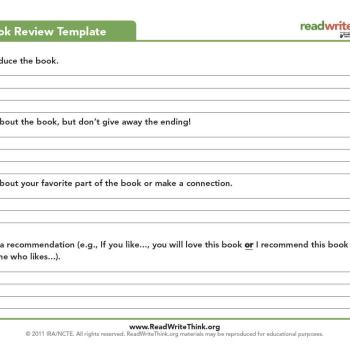
About this printout
Students can use this template as a means of communicating about a book that they have read.
Teaching with this printout
More ideas to try.
As students begin reading books at a young age, it is important to teach them to communicate their thoughts and ideas about the books they read. This template is a good way to teach students to begin putting their thoughts on a text into written form. Students will be able to process the information they read in a given text and process their ideas. Additionally, the Book Review Template allows the teacher to check a student's comprehension of a certain text to assess and inform instruction.
- Create a bulletin board with book reviews done by different students. The bulletin board can be organized by different genres of books or in other ways that are useful to students. Students can use this bulletin board as a way to read about their peers' thoughts on different books and to find books that they, too, might enjoy reading.
- At the beginning of the school year, do a read aloud and have students each do a book review on the same book that was read to the class. Have select students share their book reviews and/or thoughts on a book. Follow up by having a class discussion about why all of the book reviews are not alike, even though they were done on the same book. This discussion will familiarize students with different opinions and thoughts on the same books, and will also give struggling students a more concrete idea of how to do future book reviews on their own.
- Print this resource
Explore Resources by Grade
- Kindergarten K

Join Discovery, the new community for book lovers
Trust book recommendations from real people, not robots 🤓
Blog – Posted on Friday, Mar 29
17 book review examples to help you write the perfect review.

It’s an exciting time to be a book reviewer. Once confined to print newspapers and journals, reviews now dot many corridors of the Internet — forever helping others discover their next great read. That said, every book reviewer will face a familiar panic: how can you do justice to a great book in just a thousand words?
As you know, the best way to learn how to do something is by immersing yourself in it. Luckily, the Internet (i.e. Goodreads and other review sites , in particular) has made book reviews more accessible than ever — which means that there are a lot of book reviews examples out there for you to view!
In this post, we compiled 17 prototypical book review examples in multiple genres to help you figure out how to write the perfect review . If you want to jump straight to the examples, you can skip the next section. Otherwise, let’s first check out what makes up a good review.
Are you interested in becoming a book reviewer? We recommend you check out Reedsy Discovery , where you can earn money for writing reviews — and are guaranteed people will read your reviews! To register as a book reviewer, sign up here.
Pro-tip : But wait! How are you sure if you should become a book reviewer in the first place? If you're on the fence, or curious about your match with a book reviewing career, take our quick quiz:
Should you become a book reviewer?
Find out the answer. Takes 30 seconds!
What must a book review contain?
Like all works of art, no two book reviews will be identical. But fear not: there are a few guidelines for any aspiring book reviewer to follow. Most book reviews, for instance, are less than 1,500 words long, with the sweet spot hitting somewhere around the 1,000-word mark. (However, this may vary depending on the platform on which you’re writing, as we’ll see later.)
In addition, all reviews share some universal elements, as shown in our book review templates . These include:
- A review will offer a concise plot summary of the book.
- A book review will offer an evaluation of the work.
- A book review will offer a recommendation for the audience.
If these are the basic ingredients that make up a book review, it’s the tone and style with which the book reviewer writes that brings the extra panache. This will differ from platform to platform, of course. A book review on Goodreads, for instance, will be much more informal and personal than a book review on Kirkus Reviews, as it is catering to a different audience. However, at the end of the day, the goal of all book reviews is to give the audience the tools to determine whether or not they’d like to read the book themselves.
Keeping that in mind, let’s proceed to some book review examples to put all of this in action.
How much of a book nerd are you, really?
Find out here, once and for all. Takes 30 seconds!
Book review examples for fiction books
Since story is king in the world of fiction, it probably won’t come as any surprise to learn that a book review for a novel will concentrate on how well the story was told .
That said, book reviews in all genres follow the same basic formula that we discussed earlier. In these examples, you’ll be able to see how book reviewers on different platforms expertly intertwine the plot summary and their personal opinions of the book to produce a clear, informative, and concise review.
Note: Some of the book review examples run very long. If a book review is truncated in this post, we’ve indicated by including a […] at the end, but you can always read the entire review if you click on the link provided.
Examples of literary fiction book reviews
Kirkus Reviews reviews Ralph Ellison’s The Invisible Man :
An extremely powerful story of a young Southern Negro, from his late high school days through three years of college to his life in Harlem.
His early training prepared him for a life of humility before white men, but through injustices- large and small, he came to realize that he was an "invisible man". People saw in him only a reflection of their preconceived ideas of what he was, denied his individuality, and ultimately did not see him at all. This theme, which has implications far beyond the obvious racial parallel, is skillfully handled. The incidents of the story are wholly absorbing. The boy's dismissal from college because of an innocent mistake, his shocked reaction to the anonymity of the North and to Harlem, his nightmare experiences on a one-day job in a paint factory and in the hospital, his lightning success as the Harlem leader of a communistic organization known as the Brotherhood, his involvement in black versus white and black versus black clashes and his disillusion and understanding of his invisibility- all climax naturally in scenes of violence and riot, followed by a retreat which is both literal and figurative. Parts of this experience may have been told before, but never with such freshness, intensity and power.
This is Ellison's first novel, but he has complete control of his story and his style. Watch it.
Lyndsey reviews George Orwell’s 1984 on Goodreads:
YOU. ARE. THE. DEAD. Oh my God. I got the chills so many times toward the end of this book. It completely blew my mind. It managed to surpass my high expectations AND be nothing at all like I expected. Or in Newspeak "Double Plus Good." Let me preface this with an apology. If I sound stunningly inarticulate at times in this review, I can't help it. My mind is completely fried.
This book is like the dystopian Lord of the Rings, with its richly developed culture and economics, not to mention a fully developed language called Newspeak, or rather more of the anti-language, whose purpose is to limit speech and understanding instead of to enhance and expand it. The world-building is so fully fleshed out and spine-tinglingly terrifying that it's almost as if George travelled to such a place, escaped from it, and then just wrote it all down.
I read Fahrenheit 451 over ten years ago in my early teens. At the time, I remember really wanting to read 1984, although I never managed to get my hands on it. I'm almost glad I didn't. Though I would not have admitted it at the time, it would have gone over my head. Or at the very least, I wouldn't have been able to appreciate it fully. […]
The New York Times reviews Lisa Halliday’s Asymmetry :
Three-quarters of the way through Lisa Halliday’s debut novel, “Asymmetry,” a British foreign correspondent named Alistair is spending Christmas on a compound outside of Baghdad. His fellow revelers include cameramen, defense contractors, United Nations employees and aid workers. Someone’s mother has FedExed a HoneyBaked ham from Maine; people are smoking by the swimming pool. It is 2003, just days after Saddam Hussein’s capture, and though the mood is optimistic, Alistair is worrying aloud about the ethics of his chosen profession, wondering if reporting on violence doesn’t indirectly abet violence and questioning why he’d rather be in a combat zone than reading a picture book to his son. But every time he returns to London, he begins to “spin out.” He can’t go home. “You observe what people do with their freedom — what they don’t do — and it’s impossible not to judge them for it,” he says.
The line, embedded unceremoniously in the middle of a page-long paragraph, doubles, like so many others in “Asymmetry,” as literary criticism. Halliday’s novel is so strange and startlingly smart that its mere existence seems like commentary on the state of fiction. One finishes “Asymmetry” for the first or second (or like this reader, third) time and is left wondering what other writers are not doing with their freedom — and, like Alistair, judging them for it.
Despite its title, “Asymmetry” comprises two seemingly unrelated sections of equal length, appended by a slim and quietly shocking coda. Halliday’s prose is clean and lean, almost reportorial in the style of W. G. Sebald, and like the murmurings of a shy person at a cocktail party, often comic only in single clauses. It’s a first novel that reads like the work of an author who has published many books over many years. […]
Emily W. Thompson reviews Michael Doane's The Crossing on Reedsy Discovery :
In Doane’s debut novel, a young man embarks on a journey of self-discovery with surprising results.
An unnamed protagonist (The Narrator) is dealing with heartbreak. His love, determined to see the world, sets out for Portland, Oregon. But he’s a small-town boy who hasn’t traveled much. So, the Narrator mourns her loss and hides from life, throwing himself into rehabbing an old motorcycle. Until one day, he takes a leap; he packs his bike and a few belongings and heads out to find the Girl.
Following in the footsteps of Jack Kerouac and William Least Heat-Moon, Doane offers a coming of age story about a man finding himself on the backroads of America. Doane’s a gifted writer with fluid prose and insightful observations, using The Narrator’s personal interactions to illuminate the diversity of the United States.
The Narrator initially sticks to the highways, trying to make it to the West Coast as quickly as possible. But a hitchhiker named Duke convinces him to get off the beaten path and enjoy the ride. “There’s not a place that’s like any other,” [39] Dukes contends, and The Narrator realizes he’s right. Suddenly, the trip is about the journey, not just the destination. The Narrator ditches his truck and traverses the deserts and mountains on his bike. He destroys his phone, cutting off ties with his past and living only in the moment.
As he crosses the country, The Narrator connects with several unique personalities whose experiences and views deeply impact his own. Duke, the complicated cowboy and drifter, who opens The Narrator’s eyes to a larger world. Zooey, the waitress in Colorado who opens his heart and reminds him that love can be found in this big world. And Rosie, The Narrator’s sweet landlady in Portland, who helps piece him back together both physically and emotionally.
This supporting cast of characters is excellent. Duke, in particular, is wonderfully nuanced and complicated. He’s a throwback to another time, a man without a cell phone who reads Sartre and sleeps under the stars. Yet he’s also a grifter with a “love ‘em and leave ‘em” attitude that harms those around him. It’s fascinating to watch The Narrator wrestle with Duke’s behavior, trying to determine which to model and which to discard.
Doane creates a relatable protagonist in The Narrator, whose personal growth doesn’t erase his faults. His willingness to hit the road with few resources is admirable, and he’s prescient enough to recognize the jealousy of those who cannot or will not take the leap. His encounters with new foods, places, and people broaden his horizons. Yet his immaturity and selfishness persist. He tells Rosie she’s been a good mother to him but chooses to ignore the continuing concern from his own parents as he effectively disappears from his old life.
Despite his flaws, it’s a pleasure to accompany The Narrator on his physical and emotional journey. The unexpected ending is a fitting denouement to an epic and memorable road trip.
The Book Smugglers review Anissa Gray’s The Care and Feeding of Ravenously Hungry Girls :
I am still dipping my toes into the literally fiction pool, finding what works for me and what doesn’t. Books like The Care and Feeding of Ravenously Hungry Girls by Anissa Gray are definitely my cup of tea.
Althea and Proctor Cochran had been pillars of their economically disadvantaged community for years – with their local restaurant/small market and their charity drives. Until they are found guilty of fraud for stealing and keeping most of the money they raised and sent to jail. Now disgraced, their entire family is suffering the consequences, specially their twin teenage daughters Baby Vi and Kim. To complicate matters even more: Kim was actually the one to call the police on her parents after yet another fight with her mother. […]
Examples of children’s and YA fiction book reviews
The Book Hookup reviews Angie Thomas’ The Hate U Give :
♥ Quick Thoughts and Rating: 5 stars! I can’t imagine how challenging it would be to tackle the voice of a movement like Black Lives Matter, but I do know that Thomas did it with a finesse only a talented author like herself possibly could. With an unapologetically realistic delivery packed with emotion, The Hate U Give is a crucially important portrayal of the difficulties minorities face in our country every single day. I have no doubt that this book will be met with resistance by some (possibly many) and slapped with a “controversial” label, but if you’ve ever wondered what it was like to walk in a POC’s shoes, then I feel like this is an unflinchingly honest place to start.
In Angie Thomas’s debut novel, Starr Carter bursts on to the YA scene with both heart-wrecking and heartwarming sincerity. This author is definitely one to watch.
♥ Review: The hype around this book has been unquestionable and, admittedly, that made me both eager to get my hands on it and terrified to read it. I mean, what if I was to be the one person that didn’t love it as much as others? (That seems silly now because of how truly mesmerizing THUG was in the most heartbreakingly realistic way.) However, with the relevancy of its summary in regards to the unjust predicaments POC currently face in the US, I knew this one was a must-read, so I was ready to set my fears aside and dive in. That said, I had an altogether more personal, ulterior motive for wanting to read this book. […]
The New York Times reviews Melissa Albert’s The Hazel Wood :
Alice Crewe (a last name she’s chosen for herself) is a fairy tale legacy: the granddaughter of Althea Proserpine, author of a collection of dark-as-night fairy tales called “Tales From the Hinterland.” The book has a cult following, and though Alice has never met her grandmother, she’s learned a little about her through internet research. She hasn’t read the stories, because her mother, Ella Proserpine, forbids it.
Alice and Ella have moved from place to place in an attempt to avoid the “bad luck” that seems to follow them. Weird things have happened. As a child, Alice was kidnapped by a man who took her on a road trip to find her grandmother; he was stopped by the police before they did so. When at 17 she sees that man again, unchanged despite the years, Alice panics. Then Ella goes missing, and Alice turns to Ellery Finch, a schoolmate who’s an Althea Proserpine superfan, for help in tracking down her mother. Not only has Finch read every fairy tale in the collection, but handily, he remembers them, sharing them with Alice as they journey to the mysterious Hazel Wood, the estate of her now-dead grandmother, where they hope to find Ella.
“The Hazel Wood” starts out strange and gets stranger, in the best way possible. (The fairy stories Finch relays, which Albert includes as their own chapters, are as creepy and evocative as you’d hope.) Albert seamlessly combines contemporary realism with fantasy, blurring the edges in a way that highlights that place where stories and real life convene, where magic contains truth and the world as it appears is false, where just about anything can happen, particularly in the pages of a very good book. It’s a captivating debut. […]
James reviews Margaret Wise Brown’s Goodnight, Moon on Goodreads:
Goodnight Moon by Margaret Wise Brown is one of the books that followers of my blog voted as a must-read for our Children's Book August 2018 Readathon. Come check it out and join the next few weeks!
This picture book was such a delight. I hadn't remembered reading it when I was a child, but it might have been read to me... either way, it was like a whole new experience! It's always so difficult to convince a child to fall asleep at night. I don't have kids, but I do have a 5-month-old puppy who whines for 5 minutes every night when he goes in his cage/crate (hopefully he'll be fully housebroken soon so he can roam around when he wants). I can only imagine! I babysat a lot as a teenager and I have tons of younger cousins, nieces, and nephews, so I've been through it before, too. This was a believable experience, and it really helps show kids how to relax and just let go when it's time to sleep.
The bunny's are adorable. The rhymes are exquisite. I found it pretty fun, but possibly a little dated given many of those things aren't normal routines anymore. But the lessons to take from it are still powerful. Loved it! I want to sample some more books by this fine author and her illustrators.
Publishers Weekly reviews Elizabeth Lilly’s Geraldine :
This funny, thoroughly accomplished debut opens with two words: “I’m moving.” They’re spoken by the title character while she swoons across her family’s ottoman, and because Geraldine is a giraffe, her full-on melancholy mode is quite a spectacle. But while Geraldine may be a drama queen (even her mother says so), it won’t take readers long to warm up to her. The move takes Geraldine from Giraffe City, where everyone is like her, to a new school, where everyone else is human. Suddenly, the former extrovert becomes “That Giraffe Girl,” and all she wants to do is hide, which is pretty much impossible. “Even my voice tries to hide,” she says, in the book’s most poignant moment. “It’s gotten quiet and whispery.” Then she meets Cassie, who, though human, is also an outlier (“I’m that girl who wears glasses and likes MATH and always organizes her food”), and things begin to look up.
Lilly’s watercolor-and-ink drawings are as vividly comic and emotionally astute as her writing; just when readers think there are no more ways for Geraldine to contort her long neck, this highly promising talent comes up with something new.
Examples of genre fiction book reviews
Karlyn P reviews Nora Roberts’ Dark Witch , a paranormal romance novel , on Goodreads:
4 stars. Great world-building, weak romance, but still worth the read.
I hesitate to describe this book as a 'romance' novel simply because the book spent little time actually exploring the romance between Iona and Boyle. Sure, there IS a romance in this novel. Sprinkled throughout the book are a few scenes where Iona and Boyle meet, chat, wink at each, flirt some more, sleep together, have a misunderstanding, make up, and then profess their undying love. Very formulaic stuff, and all woven around the more important parts of this book.
The meat of this book is far more focused on the story of the Dark witch and her magically-gifted descendants living in Ireland. Despite being weak on the romance, I really enjoyed it. I think the book is probably better for it, because the romance itself was pretty lackluster stuff.
I absolutely plan to stick with this series as I enjoyed the world building, loved the Ireland setting, and was intrigued by all of the secondary characters. However, If you read Nora Roberts strictly for the romance scenes, this one might disappoint. But if you enjoy a solid background story with some dark magic and prophesies, you might enjoy it as much as I did.
I listened to this one on audio, and felt the narration was excellent.
Emily May reviews R.F. Kuang’s The Poppy Wars , an epic fantasy novel , on Goodreads:
“But I warn you, little warrior. The price of power is pain.”
Holy hell, what did I just read??
➽ A fantasy military school
➽ A rich world based on modern Chinese history
➽ Shamans and gods
➽ Detailed characterization leading to unforgettable characters
➽ Adorable, opium-smoking mentors
That's a basic list, but this book is all of that and SO MUCH MORE. I know 100% that The Poppy War will be one of my best reads of 2018.
Isn't it just so great when you find one of those books that completely drags you in, makes you fall in love with the characters, and demands that you sit on the edge of your seat for every horrific, nail-biting moment of it? This is one of those books for me. And I must issue a serious content warning: this book explores some very dark themes. Proceed with caution (or not at all) if you are particularly sensitive to scenes of war, drug use and addiction, genocide, racism, sexism, ableism, self-harm, torture, and rape (off-page but extremely horrific).
Because, despite the fairly innocuous first 200 pages, the title speaks the truth: this is a book about war. All of its horrors and atrocities. It is not sugar-coated, and it is often graphic. The "poppy" aspect refers to opium, which is a big part of this book. It is a fantasy, but the book draws inspiration from the Second Sino-Japanese War and the Rape of Nanking.
Crime Fiction Lover reviews Jessica Barry’s Freefall , a crime novel:
In some crime novels, the wrongdoing hits you between the eyes from page one. With others it’s a more subtle process, and that’s OK too. So where does Freefall fit into the sliding scale?
In truth, it’s not clear. This is a novel with a thrilling concept at its core. A woman survives plane crash, then runs for her life. However, it is the subtleties at play that will draw you in like a spider beckoning to an unwitting fly.
Like the heroine in Sharon Bolton’s Dead Woman Walking, Allison is lucky to be alive. She was the only passenger in a private plane, belonging to her fiancé, Ben, who was piloting the expensive aircraft, when it came down in woodlands in the Colorado Rockies. Ally is also the only survivor, but rather than sitting back and waiting for rescue, she is soon pulling together items that may help her survive a little longer – first aid kit, energy bars, warm clothes, trainers – before fleeing the scene. If you’re hearing the faint sound of alarm bells ringing, get used to it. There’s much, much more to learn about Ally before this tale is over.
Kirkus Reviews reviews Ernest Cline’s Ready Player One , a science-fiction novel :
Video-game players embrace the quest of a lifetime in a virtual world; screenwriter Cline’s first novel is old wine in new bottles.
The real world, in 2045, is the usual dystopian horror story. So who can blame Wade, our narrator, if he spends most of his time in a virtual world? The 18-year-old, orphaned at 11, has no friends in his vertical trailer park in Oklahoma City, while the OASIS has captivating bells and whistles, and it’s free. Its creator, the legendary billionaire James Halliday, left a curious will. He had devised an elaborate online game, a hunt for a hidden Easter egg. The finder would inherit his estate. Old-fashioned riddles lead to three keys and three gates. Wade, or rather his avatar Parzival, is the first gunter (egg-hunter) to win the Copper Key, first of three.
Halliday was obsessed with the pop culture of the 1980s, primarily the arcade games, so the novel is as much retro as futurist. Parzival’s great strength is that he has absorbed all Halliday’s obsessions; he knows by heart three essential movies, crossing the line from geek to freak. His most formidable competitors are the Sixers, contract gunters working for the evil conglomerate IOI, whose goal is to acquire the OASIS. Cline’s narrative is straightforward but loaded with exposition. It takes a while to reach a scene that crackles with excitement: the meeting between Parzival (now world famous as the lead contender) and Sorrento, the head of IOI. The latter tries to recruit Parzival; when he fails, he issues and executes a death threat. Wade’s trailer is demolished, his relatives killed; luckily Wade was not at home. Too bad this is the dramatic high point. Parzival threads his way between more ’80s games and movies to gain the other keys; it’s clever but not exciting. Even a romance with another avatar and the ultimate “epic throwdown” fail to stir the blood.
Too much puzzle-solving, not enough suspense.
Book review examples for non-fiction books
Nonfiction books are generally written to inform readers about a certain topic. As such, the focus of a nonfiction book review will be on the clarity and effectiveness of this communication . In carrying this out, a book review may analyze the author’s source materials and assess the thesis in order to determine whether or not the book meets expectations.
Again, we’ve included abbreviated versions of long reviews here, so feel free to click on the link to read the entire piece!
The Washington Post reviews David Grann’s Killers of the Flower Moon :
The arc of David Grann’s career reminds one of a software whiz-kid or a latest-thing talk-show host — certainly not an investigative reporter, even if he is one of the best in the business. The newly released movie of his first book, “The Lost City of Z,” is generating all kinds of Oscar talk, and now comes the release of his second book, “Killers of the Flower Moon: The Osage Murders and the Birth of the FBI,” the film rights to which have already been sold for $5 million in what one industry journal called the “biggest and wildest book rights auction in memory.”
Grann deserves the attention. He’s canny about the stories he chases, he’s willing to go anywhere to chase them, and he’s a maestro in his ability to parcel out information at just the right clip: a hint here, a shading of meaning there, a smartly paced buildup of multiple possibilities followed by an inevitable reversal of readerly expectations or, in some cases, by a thrilling and dislocating pull of the entire narrative rug.
All of these strengths are on display in “Killers of the Flower Moon.” Around the turn of the 20th century, oil was discovered underneath Osage lands in the Oklahoma Territory, lands that were soon to become part of the state of Oklahoma. Through foresight and legal maneuvering, the Osage found a way to permanently attach that oil to themselves and shield it from the prying hands of white interlopers; this mechanism was known as “headrights,” which forbade the outright sale of oil rights and granted each full member of the tribe — and, supposedly, no one else — a share in the proceeds from any lease arrangement. For a while, the fail-safes did their job, and the Osage got rich — diamond-ring and chauffeured-car and imported-French-fashion rich — following which quite a large group of white men started to work like devils to separate the Osage from their money. And soon enough, and predictably enough, this work involved murder. Here in Jazz Age America’s most isolated of locales, dozens or even hundreds of Osage in possession of great fortunes — and of the potential for even greater fortunes in the future — were dispatched by poison, by gunshot and by dynamite. […]
Stacked Books reviews Malcolm Gladwell’s Outliers :
I’ve heard a lot of great things about Malcolm Gladwell’s writing. Friends and co-workers tell me that his subjects are interesting and his writing style is easy to follow without talking down to the reader. I wasn’t disappointed with Outliers. In it, Gladwell tackles the subject of success – how people obtain it and what contributes to extraordinary success as opposed to everyday success.
The thesis – that our success depends much more on circumstances out of our control than any effort we put forth – isn’t exactly revolutionary. Most of us know it to be true. However, I don’t think I’m lying when I say that most of us also believe that we if we just try that much harder and develop our talent that much further, it will be enough to become wildly successful, despite bad or just mediocre beginnings. Not so, says Gladwell.
Most of the evidence Gladwell gives us is anecdotal, which is my favorite kind to read. I can’t really speak to how scientifically valid it is, but it sure makes for engrossing listening. For example, did you know that successful hockey players are almost all born in January, February, or March? Kids born during these months are older than the others kids when they start playing in the youth leagues, which means they’re already better at the game (because they’re bigger). Thus, they get more play time, which means their skill increases at a faster rate, and it compounds as time goes by. Within a few years, they’re much, much better than the kids born just a few months later in the year. Basically, these kids’ birthdates are a huge factor in their success as adults – and it’s nothing they can do anything about. If anyone could make hockey interesting to a Texan who only grudgingly admits the sport even exists, it’s Gladwell. […]
Quill and Quire reviews Rick Prashaw’s Soar, Adam, Soar :
Ten years ago, I read a book called Almost Perfect. The young-adult novel by Brian Katcher won some awards and was held up as a powerful, nuanced portrayal of a young trans person. But the reality did not live up to the book’s billing. Instead, it turned out to be a one-dimensional and highly fetishized portrait of a trans person’s life, one that was nevertheless repeatedly dubbed “realistic” and “affecting” by non-transgender readers possessing only a vague, mass-market understanding of trans experiences.
In the intervening decade, trans narratives have emerged further into the literary spotlight, but those authored by trans people ourselves – and by trans men in particular – have seemed to fall under the shadow of cisgender sensationalized imaginings. Two current Canadian releases – Soar, Adam, Soar and This One Looks Like a Boy – provide a pointed object lesson into why trans-authored work about transgender experiences remains critical.
To be fair, Soar, Adam, Soar isn’t just a story about a trans man. It’s also a story about epilepsy, the medical establishment, and coming of age as seen through a grieving father’s eyes. Adam, Prashaw’s trans son, died unexpectedly at age 22. Woven through the elder Prashaw’s narrative are excerpts from Adam’s social media posts, giving us glimpses into the young man’s interior life as he traverses his late teens and early 20s. […]
Book Geeks reviews Elizabeth Gilbert’s Eat, Pray, Love :
WRITING STYLE: 3.5/5
SUBJECT: 4/5
CANDIDNESS: 4.5/5
RELEVANCE: 3.5/5
ENTERTAINMENT QUOTIENT: 3.5/5
“Eat Pray Love” is so popular that it is almost impossible to not read it. Having felt ashamed many times on my not having read this book, I quietly ordered the book (before I saw the movie) from amazon.in and sat down to read it. I don’t remember what I expected it to be – maybe more like a chick lit thing but it turned out quite different. The book is a real story and is a short journal from the time when its writer went travelling to three different countries in pursuit of three different things – Italy (Pleasure), India (Spirituality), Bali (Balance) and this is what corresponds to the book’s name – EAT (in Italy), PRAY (in India) and LOVE (in Bali, Indonesia). These are also the three Is – ITALY, INDIA, INDONESIA.
Though she had everything a middle-aged American woman can aspire for – MONEY, CAREER, FRIENDS, HUSBAND; Elizabeth was not happy in her life, she wasn’t happy in her marriage. Having suffered a terrible divorce and terrible breakup soon after, Elizabeth was shattered. She didn’t know where to go and what to do – all she knew was that she wanted to run away. So she set out on a weird adventure – she will go to three countries in a year and see if she can find out what she was looking for in life. This book is about that life changing journey that she takes for one whole year. […]
Emily May reviews Michelle Obama’s Becoming on Goodreads:
Look, I'm not a happy crier. I might cry at songs about leaving and missing someone; I might cry at books where things don't work out; I might cry at movies where someone dies. I've just never really understood why people get all choked up over happy, inspirational things. But Michelle Obama's kindness and empathy changed that. This book had me in tears for all the right reasons.
This is not really a book about politics, though political experiences obviously do come into it. It's a shame that some will dismiss this book because of a difference in political opinion, when it is really about a woman's life. About growing up poor and black on the South Side of Chicago; about getting married and struggling to maintain that marriage; about motherhood; about being thrown into an amazing and terrifying position.
I hate words like "inspirational" because they've become so overdone and cheesy, but I just have to say it-- Michelle Obama is an inspiration. I had the privilege of seeing her speak at The Forum in Inglewood, and she is one of the warmest, funniest, smartest, down-to-earth people I have ever seen in this world.
And yes, I know we present what we want the world to see, but I truly do think it's genuine. I think she is someone who really cares about people - especially kids - and wants to give them better lives and opportunities.
She's obviously intelligent, but she also doesn't gussy up her words. She talks straight, with an openness and honesty rarely seen. She's been one of the most powerful women in the world, she's been a graduate of Princeton and Harvard Law School, she's had her own successful career, and yet she has remained throughout that same girl - Michelle Robinson - from a working class family in Chicago.
I don't think there's anyone who wouldn't benefit from reading this book.
Hopefully, this post has given you a better idea of how to write a book review. You might be wondering how to put all of this knowledge into action now! Many book reviewers start out by setting up a book blog. If you don’t have time to research the intricacies of HTML, check out Reedsy Discovery — where you can read indie books for free and review them without going through the hassle of creating a blog. To register as a book reviewer , go here .
And if you’d like to see even more book review examples, simply go to this directory of book review blogs and click on any one of them to see a wealth of good book reviews. Beyond that, it's up to you to pick up a book and pen — and start reviewing!
Continue reading
More posts from across the blog.

25 Best Bookshelves Money Can Buy
Sit back and browse some of the best bookshelves money can buy! Whether you wish to flaunt your bold personality at work or add a rustic flair to your home, you’ll surely find your ideal bookshelf here.
The 60 Best Fantasy Books of All Time
Whether you’ve sat around waiting for your Hogwarts letter or looked for Narnia in the back of a closet, you've probably dreamt of stepping into your favorite fantasy books and leaving the real world behind. But the genre isn’t all witches, wardrobes, and whimsy!...
The 10 Best H.P. Lovecraft Books for New Readers
The horror canon simply wouldn’t be the same without H.P. Lovecraft — the writer best known for creating Cthulhu, a winged Kraken-like creature, along with an entire mythos of similarly monstrous “Old Ones.” And though Lovecraft’s terrifying tales have been captivating read...
Heard about Reedsy Discovery?
Trust real people, not robots, to give you book recommendations.
Or sign up with an
Or sign up with your social account
- Submit your book
- Reviewer directory

Want to be a book reviewer?
Review new books and start building your portfolio.
404 Not found
404 Not found
middle school book reviews
All Formats
Resource types, all resource types.
- Rating Count
- Price (Ascending)
- Price (Descending)
- Most Recent
Middle school book reviews
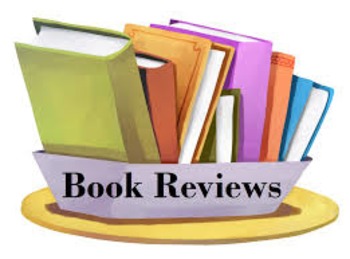
Middle School Reading Project: Writing a Book Review
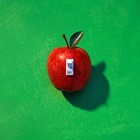
Forms of Energy Mini Book : definitions, examples, review , cut & paste

Middle School Math Review Book Digital Bundle
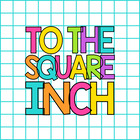
Book Review Template for Middle School

Independent Reading Banners | Book Review Project Middle & High School Any Novel
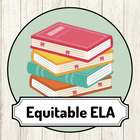
- Google Drive™ folder
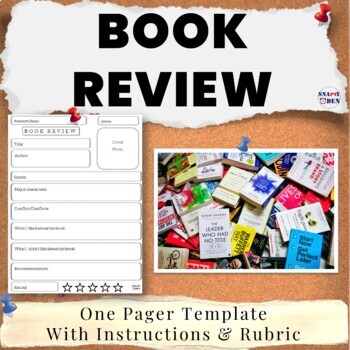
Book Review - Middle School One Pager Template

Middle School Review Flip Book : Decimals, Fractions, Multiplication, Solve for X
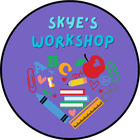
Book Review - Doodle Book Report - Use with any book !
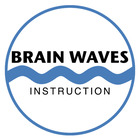
Book Report | 3D Book Review Dodecahedron Project

Fraction Flip Book | Fraction Review and Equivalent Fractions

Book Recommendation Sheet | Review Alternative Book Report Template Reflection
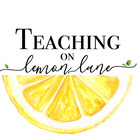
ELA Assessment - Exam w/Test Review MINI- BOOK - w/Digital Test- Standards Based
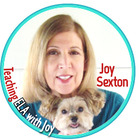
- Google Apps™
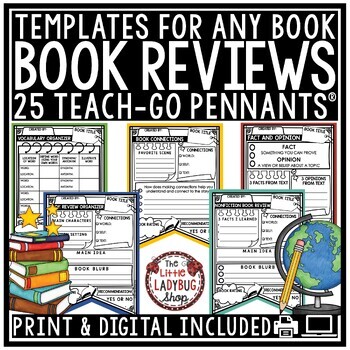
Book Review Report Templates Reading Response Sheets Graphic Organizers

- Easel Activity
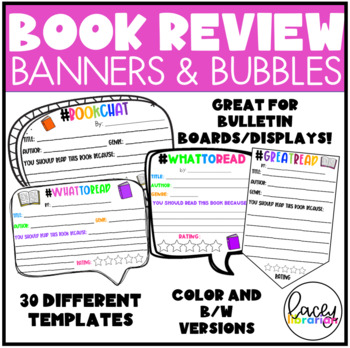
Book Recommendation/ Book Review Banners / Speech Bubbles
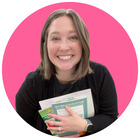
Book Report Template Book Review Report Template March is Reading Month
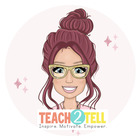
Doodle Book Report Templates - 5 Doodle Book Reviews for ANY BOOK !
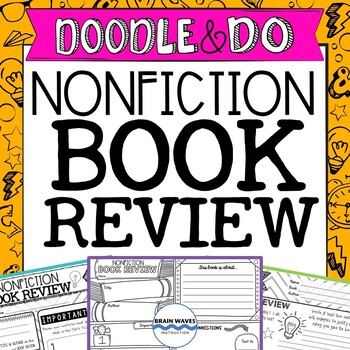
Nonfiction Book Report, Doodle Book Review for Nonfiction Texts, Nonfiction Text
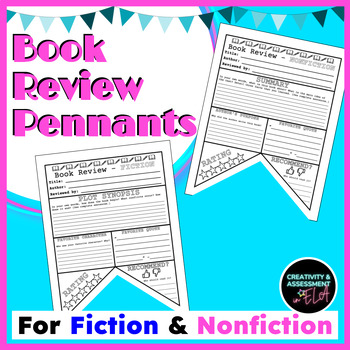
Book Review Book Report Pennant Banner Template for ANY Fiction OR Nonfiction
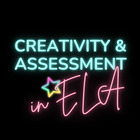
Book Review Templates Book Report Fiction and Nonfiction Text Reading Response
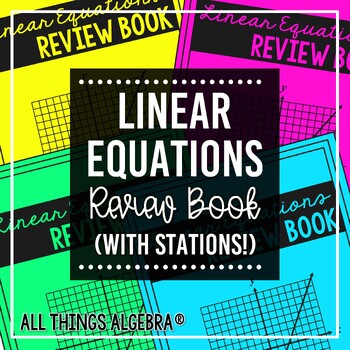
Linear Equations | Review Book
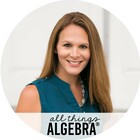
Factoring Polynomials (Algebra 1) | Review Book

Exponent Rules (Laws of Exponents) | Review Book
![sample book reviews for middle school students Preview of Book Review Templates for K-5+ [Differentiated with over 20 different designs!]](https://ecdn.teacherspayteachers.com/thumbitem/Book-Review-Templates-for-K-5-Differentiated-with-over-20-different-designs--2559796-1659378603/original-2559796-1.jpg)
Book Review Templates for K-5+ [Differentiated with over 20 different designs!]

Algebra 1 Review | Flip Book
- We're hiring
- Help & FAQ
- Privacy policy
- Student privacy
- Terms of service
- Tell us what you think

Articles / Picture Books
What Picture Books Add to a Middle School Class
by MiddleWeb · 05/05/2024
By Katie Durkin
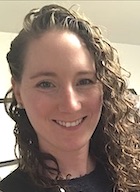
In this class, we participated in book clubs, read multiple whole-class novels, and discussed modern trends in middle grade and young adult texts, all with the purpose of taking these strategies into the classroom.
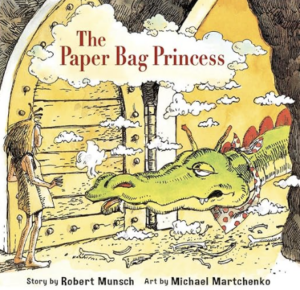
Our first read-aloud was The Paper Bag Princess by Robert Munsch. We discussed how this particular picture book could be used as a model for teaching theme. I remember thinking how brilliant this idea was at the time, even going as far as to purchase a copy of the picture book with what little money I had as an undergrad.
But it wasn’t until the past two school years that I really started embracing reading picture books – for three reasons. I believe that including picture books in my curricula in middle school invokes a sense of nostalgia for the students, helps them to grasp difficult abstract concepts, and creates a shared experience I can leverage in the future.
Nostalgia is a powerful influencer for many people, but I would argue it’s especially so for middle schoolers. At first I was nervous about bringing back a story time element in my classroom. Knowing middle schoolers’ personalities, I expected there to be a bit of pushback, and the first time I tried it, some of them did grumble and grip.
But now that I have used picture books with two different cohorts of students, I have seen how much they love story time and miss it from their elementary days. I actually create a space in my classroom where students can comfortably sit on the floor and be able to see the pictures in the story.
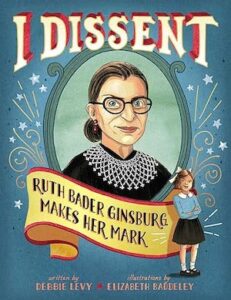
Click on covers to learn more.
I approach these read alouds in a number of different ways, depending on the focus for the day’s lesson. Sometimes I will structure it like a traditional read aloud, where I will demonstrate my own thinking, purposely stopping at different points in the story.
Other times I ask students to make sure they have someone to talk to as I’ve strategically found places in the picture book for discussion.
Sometimes I will read a whole picture book in one sitting. Other times I will stop at particular places to leave the students hanging because the pages of the day directly relate to our lesson.
Many of my students love story time so much they actually request it if we haven’t done it for a while. Being read to is a powerful practice: it allows students to focus more on the story through the images (enjoyment) and also grasp more difficult concepts they can apply to their own reading (growth).
Encouraging abstract thinking
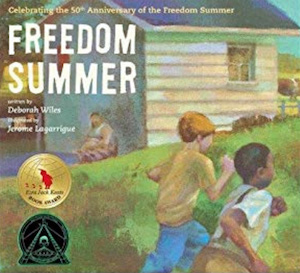
Two of our biggest units of the year are historical fiction and social justice. Here students are asked to think about really difficult concepts. In historical fiction, students are asked to consider how authors use history to tell fictional stories. In our social justice unit, they explore the topics of power, privilege, change agentry, empathy, and activism.
Each of these units requires students to use both fiction and nonfiction to synthesize their thinking about key concepts, which is not an easy task. In the historical fiction unit we read one picture book alongside Newsela articles to figure out how the author used history in the fictional story.
In our social justice unit we read various picture books about many different topics and use the characters’ stories to think about the roles that power, privilege, empathy and activism play in a particular book.
Students also look for change agents and begin to develop theories about traits change agents possess that help them bring about positive, or in some cases, negative change. I have noticed they are better able to grasp these concepts using the picture books as an anchor before applying strategic thinking to their own more text-driven books.
Creating shared experiences
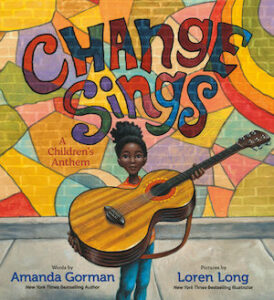
When I pull students to review these concepts, I have been able to fall back on using the picture books as examples to spark conversations that prime their thinking.
I have directly seen the impact this has on students, They are able to see how they can apply a difficult concept – for example power or privilege – to a picture book and then work to transfer it to their own story or a chapter book they are reading.
The picture books I have read to the class have been integral in providing these shared experiences. I have even been able to refer back to many different titles we read earlier in the year when conferring with students. Arguably, this has been the most important part of integrating picture books in my classroom.
In summary, I find that reading these books to the whole class has provided me with an arsenal of diverse tools that help me meet the students where they are.
Finding the picture books
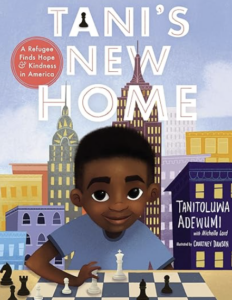
I’ve turned to two places. First, I worked with my library media specialist who has a wealth of knowledge. I went in with the specific purpose of finding books to relate to our historical fiction and social justice units, and she was able to provide me a myriad list of options that I then perused to choose books that would best fit the units.
I’ve also used the internet, reading blogs and reviews on various websites to choose books that were recent and relevant. There are so many resources available to teachers now to find picture books that will fit any need – from the School Library Journal to GoodReads .
I’m now fortunate that I have a stockpile of books to choose from in the future. I also plan to grow my collection as new titles are released and reviewed.
I’ve moved from skeptic to advocate
I know reading picturebooks in the English Language Arts classroom is not a novel idea. But as a past skeptic of using this strategy with middle schoolers, I can say that this is a practice I plan to use consistently in years to come.
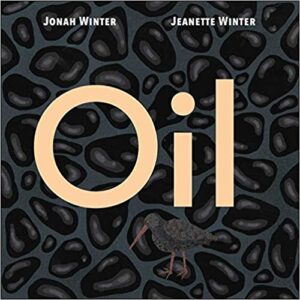
I will end with a call of action. Think about places in your own curriculum where you can infuse picture books. This practice doesn’t need limited to be limited the English Language Arts classroom. Picture books can be used in myriad ways across disciplines and could be a great addition to your classroom routines.
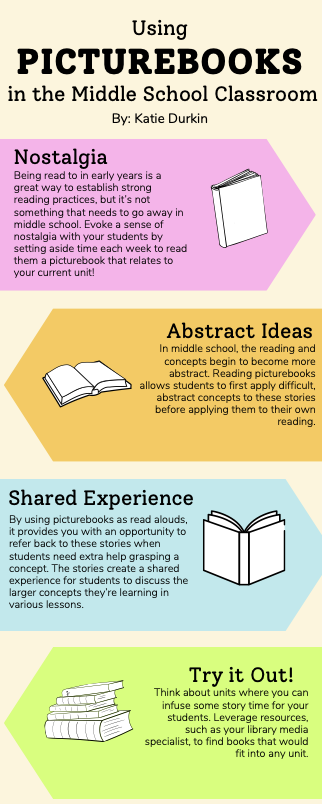
Dr. Katie Durkin ( @kmerz610 ) has been teaching middle school students for over a decade, and currently teaches English Language Arts at public Middlebrook School in Wilton, Connecticut, where she is the 7th Grade Team Leader.
Katie is a zealous reader of middle grade and young adult books and enjoys sharing her love and passion for reading with her students. In 2022 she earned her doctorate from Northeastern University, where her dissertation research examined the impact of classroom libraries on middle school students’ reading engagement.
Katie was the 2020 recipient of the Edwyna Wheadon Postgraduate Training Scholarship from the NCTE. She writes regularly for MiddleWeb and in early 2023 launched a podcast, That’s Novel Reading .
Share this:
Tags: abstract concepts historical fiction Katie Durkin middle school nostalgia picture books Read-Alouds shared experience social justice
MiddleWeb is all about the middle grades, with great 4-8 resources, book reviews, and guest posts by educators who support the success of young adolescents. And be sure to subscribe to MiddleWeb SmartBrief for the latest middle grades news & commentary from around the USA.
3 Responses
- Pingbacks 0
This is so inspiring! Thank you!
This approach provides a needed balance between decoding words to get the gist of a text and digging deeper into the meaning and themes of texts that all students can be successful with. A great way to support the love of reading and to introduce strategies for text analysis that can be used with more complex texts.
This approach provides a needed balance between decoding words to get the gist of a text and digging deeper into the meaning and themes of texts that all students can be successful with. A great way to support the love of reading and to introduce strategies for text analysis.
Leave a Reply Cancel reply
Your email address will not be published. Required fields are marked *
Notify me of follow-up comments by email.
Notify me of new posts by email.
This site uses Akismet to reduce spam. Learn how your comment data is processed .
- Popular Posts
- Recent Posts
- Recent Comments

Book Reviews / Gifted Education
Implementing the Moving Parts of GT Coaching

Articles / Deeper Learning
Try This UDL Higher Order Thinking Strategy

Articles / Mathematics
Math: the Perfect Place to Teach Character

Book Reviews / World Languages
Building Skills in the World Language Class

Collaboration / Making Questions Count
Nurturing Students As Collaborative Contributors

Equity / The Unstoppable ML Teacher
Equity for MLs Begins with Equitable Schedules

Articles / Reading
Relating Classic Texts to Students’ Lives Today

end-of-year learning / Resources
Looking Ahead to the Last Weeks of School!

Articles / Literacy
Teach Students to Read (and Write with) Video

Articles / Digital Resources
New Teachers: Lean on Those Digital Resources
- Karin Hess says: This approach provides a needed balance between decoding words to get...
- Sunday Cummins says: So helpful! Thank you!
- K. Sunday Cummins says: This is so inspiring! Thank you!
- Judith Wilson says: Write On! I've always believed in the power of watching, analyzing,...
Sign Up & Receive the Latest News about Our Content…
Email address:
First Name:
Read our Privacy Policy
BOOK REVIEWS

Mapping Out Diverse Gifted Programs

Using 100-Word Stories for Expansive Writing

What to Expect from AI in Class and Beyond

Strategies for Teaching Against Disinformation

The Democratic Roots Essential to Literacy

How to Reclaim Your Energy, Passion, & Time

A Leadership Blueprint for Growth and Success

A How-to Guide to Better Engage Your Students

10 Tools to Help Kids Develop Their Talents

The Reading Strategies Book Gets an Update

Opportunities for Swift Achievement Gains

Teaching for Retention, Application and Transfer

Strategies to Adjust ‘Up’ What Students Know

Assuring Just, Inclusive Learning for Newcomers

Building Bridges That Cultivate Teacher Growth

SEL, Civic Engagement, & a Healthy Democracy

An Enhanced Edition of ‘When Kids Can’t Read’

Shifting to Asset-Based Literacy Assessments
- Skip to primary navigation
- Skip to main content
- Skip to primary sidebar
- Skip to footer
Don't Miss a Post! Subscribe

- Book Summaries
- Books for Teachers
- Research Methodology Books
- Themed Book Lists
- Beyond Books

Selected Reads
A blog for bibliophiles covering everything related to books from reviews and summaries to quotes and open articles.
14 Best Writing Books for Middle and High School Students
By Med Kharbach, PhD | Published: March 23, 2023 | Updated: March 21, 2024
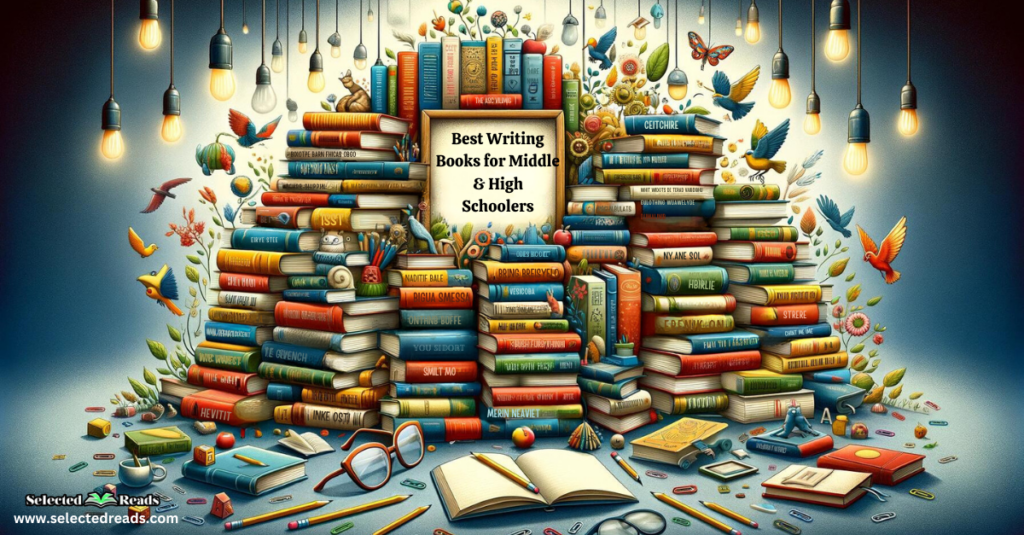
Writing can be a daunting task for middle and high school students. I taught them for many years and I know exactly how they feel about it. I used to tell my students that to be a good writer you need to be a good reader. Unlike other literacy skills, writing is strictly related to reading, the more you read the better writer you become.
[ Related: Best Essay Writing Books for High School Students ]
With this in mind, I went ahead and curated this list of some very good writing books for middle and high school students. From the basics of essay-writing to finding one’s creative voice, these books offer valuable advice and guidance to improve students writing skills. Whether you’re a student yourself or a teacher of middle or high school students, these writing books will provide you with the resources and tools necessary for success.
Writing Books for Middle and High School Students
Here is our collection of writing books for middle and high school students:
1. Be a Better Writer: For School, For Fun, For Anyone Ages 10-15, by Steve Peha, Margot Carmichael Lester
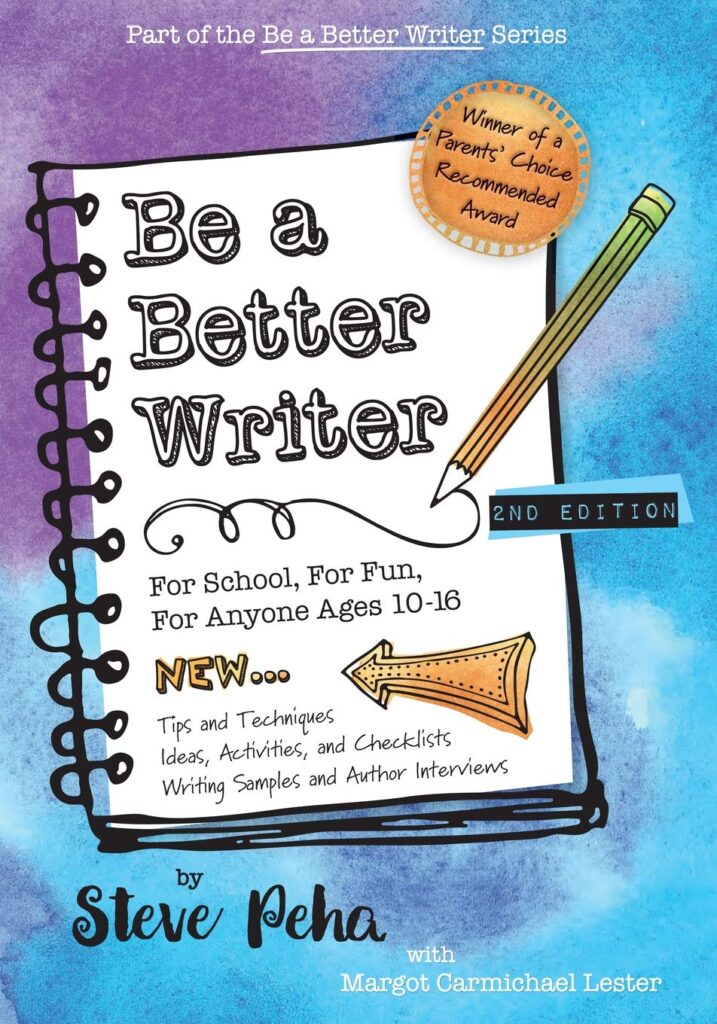
Be a Better Writer: For School, For Fun, For Anyone Ages 10-15 is a book written by Steve Peha and Margot Carmichael Lester to help you become a better writer. This book walks through each of the three sections by providing tips and strategies that will improve your writing.
For school, it includes techniques like What-Why-How and Content-Purpose-Audience to analyze arguments more effectively. For fun, it includes The Five Facts of Fiction to strategize better story lines and description. Finally, the book encourages readers to find their voice, share their stories, and become a better writer now.
2. How to Write a 5-Paragraph Essay Step-by-Step: Step-by-Step Study Skills , by J Matthews
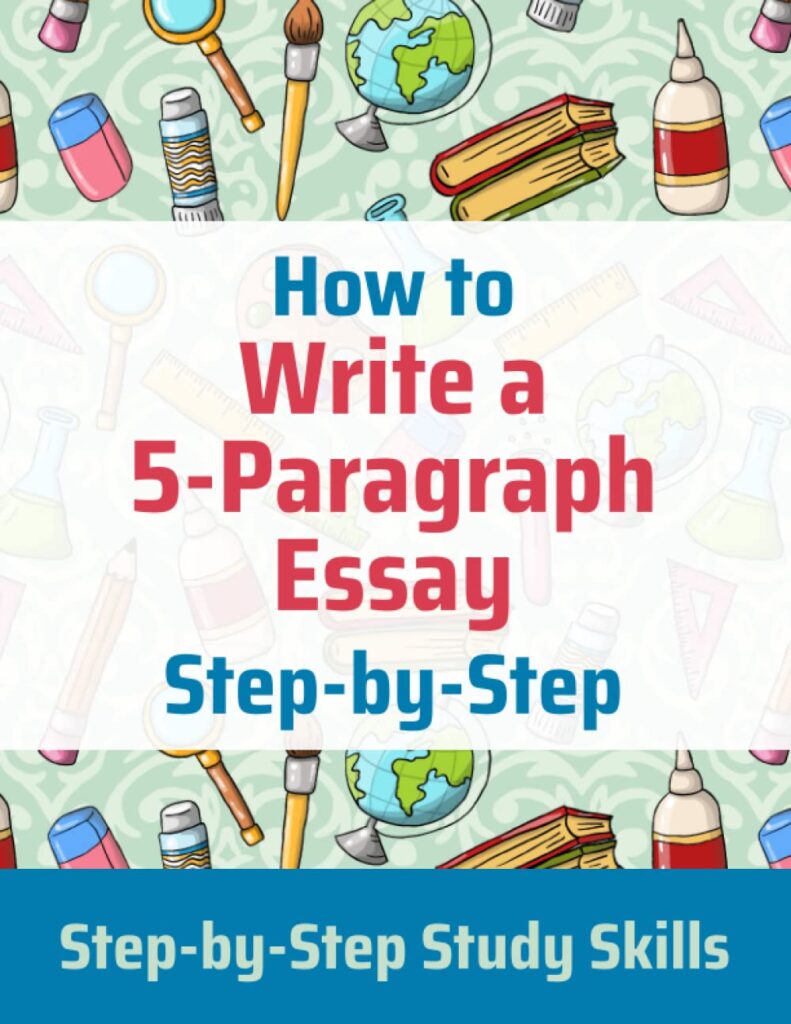
How to Write a 5-Paragraph Essay Step-by-Step: Step-by-Step Study Skills, by J Matthews is the perfect companion for any learner looking to improve their writing skills. Not only does this workbook provide a clear, step-by-step approach to essay writing, but it also gives students the confidence that they can master any essay assignment. This workbook covers all the essential aspects of an essay, from pre-writing to editing.
3. Student Voice: 100 Argument Essays by Teens on Issues That Matter to Them , by Katherine Schulten
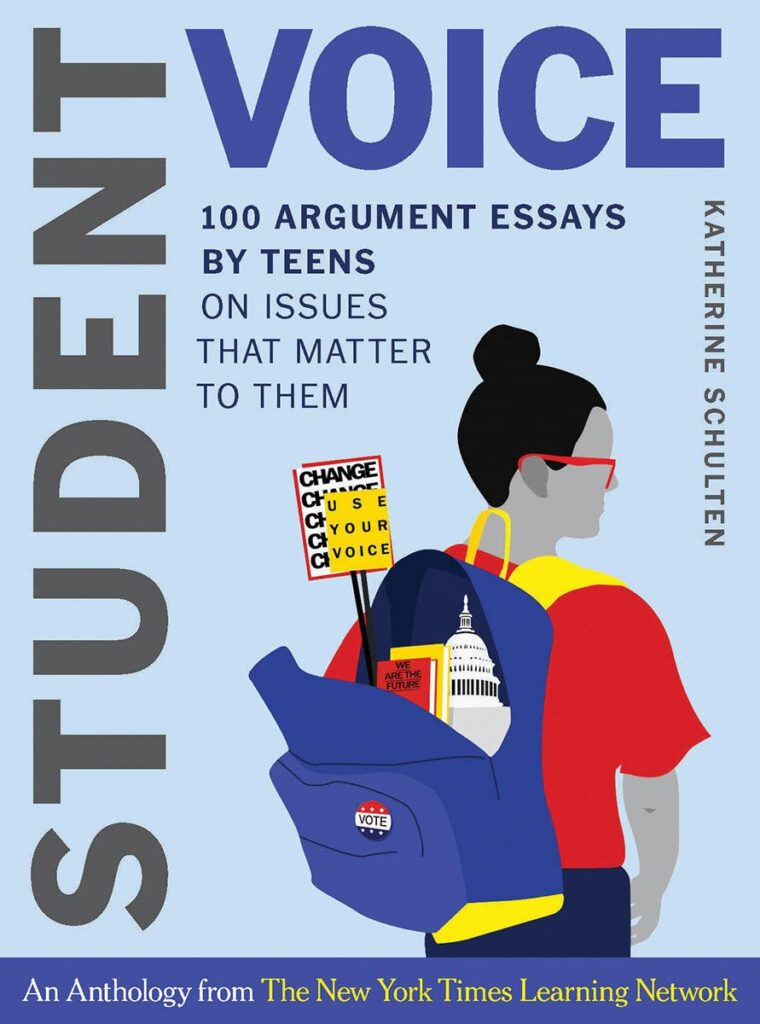
Student Voice: 100 Argument Essays by Teens on Issues That Matter to Them, by Katherine Schulten is an anthology of essays written by young people on a variety of topics. This book not only provides an opportunity to learn from the perspectives of someone similar in age, but it is also a great way to understand the issues that are important to today’s teens.
The essays in this book cover topics such as technology, gender roles, gun control, and race. Each of the essays has been carefully selected to showcase both the student’s writing style and their ability to persuasively argue their point of view.
4. How To Write Any High School Essay: The Essential Guide , by Jesse Liebman
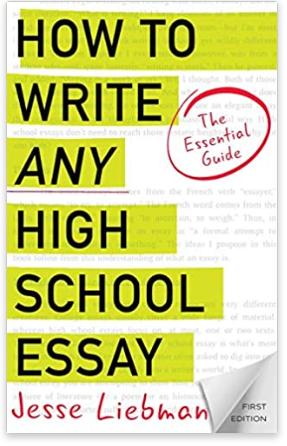
How To Write Any High School Essay: The Essential Guide, by Jesse Liebman, is a comprehensive guide to writing any high school essay, no matter the teacher or subject. It is grounded in the real-world experience of tutoring in New York City’s top schools and provides clear and creative guidance for high school writers at all levels, as well as middle schoolers looking to get ahead.
Liebman’s guide outlines the steps for writing an essay and provides sample essays to help writers develop their ideas, express them convincingly, and use their time effectively. Additionally, quick tips are provided throughout the guide to help writers stay focused and organized. How To Write Any High School Essay is essential for any student looking to excel in their English or History classes.
5. Grammar Girl Presents the Ultimate Writing Guide for Students , by Mignon Fogarty
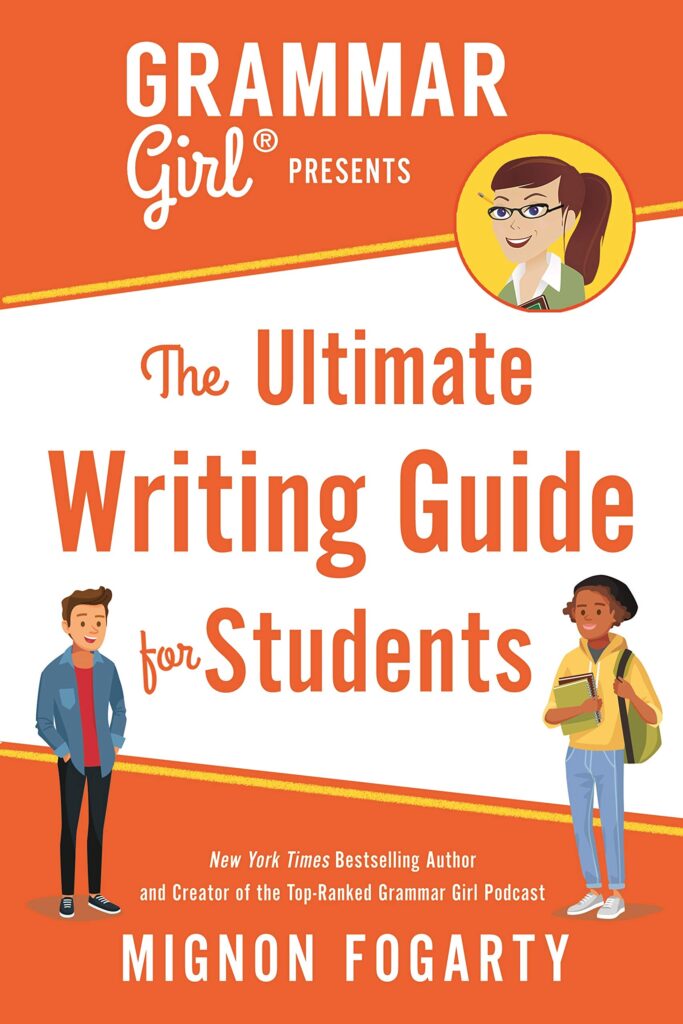
Grammar Girl Presents the Ultimate Writing Guide for Students, written by Mignon Fogarty, is a comprehensive guide for all levels of students. With the help of this guide, readers will learn how to write proper sentences and punctuation, as well as how to use their own style of writing.
In the book, Fogarty provides grammar rules in a humorous and engaging style, as well as pop quizzes to help readers understand each lesson. The book will also cover grammar and punctuation in different contexts, such as the parts of speech and how to use them properly. Finally, the book contains a writing style guide chapter, so readers can learn how to write in their own style.
6. Write Beside Them: Risk, Voice, and Clarity in High School Writing , by Penny Kittle

Write Beside Them: Risk, Voice, and Clarity in High School Writing, by Penny Kittle is a comprehensive guide for English/language arts teachers on how to teach writing. It explains best practices, instructional frameworks, genre work, skills work, assessment techniques, and Penny’s own strategies.
She provides detailed teaching information, minilessons for students’ immediate needs, profiles of individual writers, study guide, reproducibles, writing samples from writers and students, suggestions on nurturing your own writing life, and a helpful FAQ.
7. Unjournaling: Daily Writing Exercises That Are Not Personal, Not Introspective, Not Boring !, by Dawn DiPrince, Cheryl Miller Thurston

Unjournaling: Daily Writing Exercises That Are Not Personal, Not Introspective, Not Boring! is an innovative book written by Dawn DiPrince and Cheryl Miller Thurston. In it, the authors provide 200 unique writing prompts that are entirely impersonal but still engaging for students of all ages.
For example, one prompt is “Explain a new invention that would make life easier for everyone” and another is “Write a bedtime story that all the world’s cultures could agree with.” Along with these questions, the authors provide sample responses to help readers visualize how to answer these questions.
8. Burn After Writing Teen. New Edition , by Rhiannon Shove
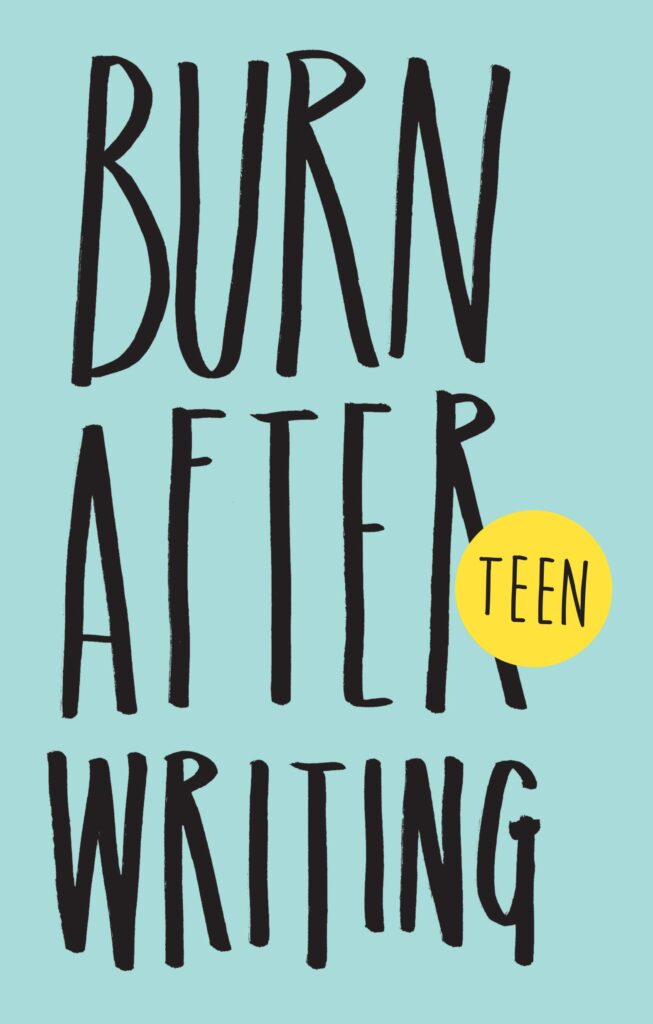
Burn After Writing Teen, by Rhiannon Shove is an interactive book designed to help young people explore who they are and who they want to be. It includes questions such as “What are your hopes and dreams for the future”, “What do you wish you had more time to do” and “What makes you unique?”
The book provides thought-provoking and inspiring activities, and encourages young people to be brave and open-minded in their responses. The book also offers an opportunity for teens to express themselves honestly, without having to worry about judgement from their peers. And at the end of it all, they can burn the book and start fresh. Burn After Writing Teen is a great tool to help teens explore their identity and learn more about themselves.
9. Rip the Page!: Adventures in Creative Writing , by Karen Benke
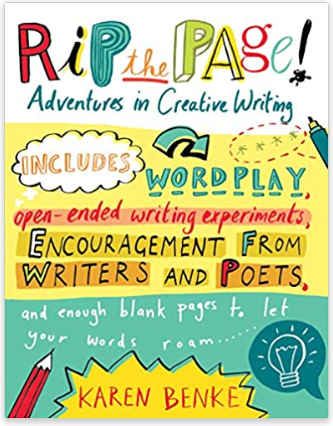
Rip the Page!: Adventures in Creative Writing, by Karen Benke is an instructional guide for unlocking creative writing potential. It includes exercises, prompts, and words to spark creativity and help writers break through writer’s block.
Readers are provided with lists of “big”, “small”, “gross-out”, and “favorite” words to help them come up with possibilities for their writing. In addition, Benke encourages readers to take dares and double-dares, which can be used to create outrageous paragraphs combining truth and lies. Finally, the book includes letters of encouragement from famous authors such as Annie Barrows, Naomi Shihab Nye, Lemony Snicket, and more.
10. Writing Magic: Creating Stories That Fly , by Gail Carson Levine

In Writing Magic: Creating Stories That Fly, Gail Carson Levine, a Newberry Honor author, provides aspiring authors with the tools they need to create captivating stories. She offers advice on generating ideas and developing characters, as well as how to craft compelling dialogue and beginnings and endings. Writing Magic also offers exercises to spark creativity and get over writer’s block.
Levine shares her wisdom with a unique, humorous voice that encourages aspiring authors to unlock their creative potential and use it to write stories that will stay in the hearts of readers. With Writing Magic, Levine promises readers they can bring their own special magic to the page and create unforgettable stories.
11. Spilling Ink: A Young Writer’s Handbook , by Ellen Potter, Anne Mazer

Spilling Ink: A Young Writer’s Handbook, by Ellen Potter and Anne Mazer, is an invaluable guidebook for aspiring young writers. It provides practical advice on how to find one’s voice, develop characters and plots, make revisions, and overcome writer’s block.
The authors include anecdotes from their own experiences as well as fun writing prompts to help jump-start projects. This book is filled with encouragement and guidance through every step of the writing process, making it an essential tool for young writers who are looking for their place in the literary world.
12. Writers INC: A Student Handbook for Writing and Learning , by Patrick Sebranek, Dave Kemper, Verne Meyer
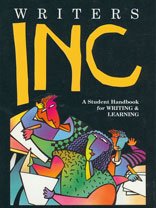
Writers INC: A Student Handbook for Writing and Learning, by Patrick Sebranek, Dave Kemper, Verne Meyer is an invaluable resource for students and professionals alike. It covers everything related to writing, from the writing process to writing essays and research papers. It provides readers with guidelines, models, rules, and friendly advice to help them with their writing. T
he book also includes sections on reading, learning, speaking, and thinking to make it a comprehensive reference book. In addition to all the information provided, Writers Inc also contains full-color maps, useful tables and charts, and historical documents.
14. Essay Writing for High School Students , by Alexander L. Terego

Essay Writing for High School Students, by Alexander L. Terego is a comprehensive guide to help students write better essays. It encourages creativity and critical thinking by introducing a “thinking outside the box” approach.
The book provides tips on how to develop a point of view and includes step-by-step instructions, along with exercises and sample essays, to illustrate the techniques. It also includes strategies for developing an effective thesis statement and constructing a strong argument.
Final thoughts
In wrapping up this exploration of invaluable writing resources for middle and high school students, I hope you’ve discovered some gems to inspire and guide young writers on their journey. The books listed offer a treasure trove of advice, strategies, and exercises tailored to developing writers, each designed to illuminate the path from initial concept to polished piece. I highly recommend exploring these titles, whether you’re a student seeking to refine your craft or an educator aiming to inspire your charges.
Related Posts
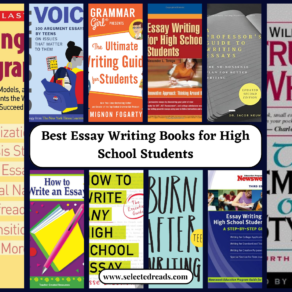
- Demystifying Dissertation Writing Summary and Takeaways
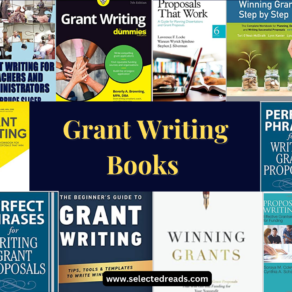
Meet Med Kharbach, PhD
Dr. Med Kharbach is an influential voice in the global educational landscape, with an extensive background in educational studies and a decade-long experience as a K-12 teacher. Holding a Ph.D. from Mount Saint Vincent University in Halifax, Canada, he brings a unique perspective to the educational world by integrating his profound academic knowledge with his hands-on teaching experience. Dr. Kharbach's academic pursuits encompass curriculum studies, discourse analysis, language learning/teaching, language and identity, emerging literacies, educational technology, and research methodologies. His work has been presented at numerous national and international conferences and published in various esteemed academic journals.
Join our mailing list
Subscribe to our email list for bite-sized book summaries, curated recommendations, and exclusive content.
Subscribe for exclusive resources .
You have successfully joined our subscriber list.
Total Price

John N. Williams
Do my essay with us and meet all your requirements.
We give maximum priority to customer satisfaction and thus, we are completely dedicated to catering to your requirements related to the essay. The given topic can be effectively unfolded by our experts but at the same time, you may have some exclusive things to be included in your writing too. Keeping that in mind, we take both your ideas and our data together to make a brilliant draft for you, which is sure to get you good grades.
Courtney Lees
Transparency through our essay writing service
Transparency is unique to our company and for my writing essay services. You will get to know everything about 'my order' that you have placed. If you want to check the continuity of the order and how the overall essay is being made, you can simply ask for 'my draft' done so far through your 'my account' section. To make changes in your work, you can simply pass on your revision to the writers via the online customer support chat. After getting ‘my’ initial draft in hand, you can go for unlimited revisions for free, in case you are not satisfied with any content of the draft. We will be constantly there by your side and will provide you with every kind of assistance with our best essay writing service.
Margurite J. Perez
Finished Papers

IMAGES
VIDEO
COMMENTS
Review by Young Mensan Connor C., age 6, Boston Mensa. Journey To Juno is the second book of the Galaxy Zack series. It is just as good as the first one. It's awesome! Zack joins the Sprockets Academy Explorers Club at school. They fly on a special trip to Juno, a new planet no one has ever visited.
Book Review Template. Here is a good book review example for 4th-grade students: "Charlotte's Web" by E.B. White — A Heartwarming Tale of Friendship. "Charlotte's Web" by E.B. White is a heartwarming tale of friendship that takes us to Zuckerman's farm, where a special pig named Wilbur forms an unlikely bond with Charlotte, a clever ...
The real value of crafting a well-written book review for a student does not lie in their ability to impact book sales. Understanding how to produce a well-written book review helps students to: Engage critically with a text. Critically evaluate a text. Respond personally to a range of different writing genres.
Parts of a book review template. If you're a student, all you have to do is give your own opinions and thoughts about the book you have read. ... Book Review Templates Middle School. Download 21 KB #20. Download 216 KB #21. Download 26 KB #22. Download 14 KB #23. Download 30 KB #24. Download 18 KB #25. Download 24 KB #26.
The first step is to plan and create an outline that includes all the points that you will have to cover in the review. Don't forget to include all the information about the characters, plot information, and some other parts of the chosen book. The three parts of a book review are: 1. Provide a Summary.
What Is a Book Review? A book review is a thorough evaluation of a book highlighting the book's plot, quality, and significance. Book reviews vary from succinct descriptions to lengthy reviews. In schoolwork, professors assign book reviews to students to form opinionated evaluations that depict the ability to synthesize research and creativity.
Book Review Examples for Middle School Students. Title: The New Policeman. Author: Kate Thompson. Genre: Fantasy. This book setting of The New Policeman takes place in two settings: one is in the town of Kinvara, Ireland and the other place is in Tír na n'Óg, or the land of eternal youth. Most of the book takes place in Tír na n'Óg.
Next, examine the key parts of the review as a class. Point out how the beginning hooks readers by sharing an interesting detail about the book. It also introduces the title and the author. Then review how the middle paragraphs answer key questions about the book. Select your writing standard type:
Title: Sample Student-Friendly Book Reviews Author: bunyi Subject: This handout from Angela Bunyi's Writing Book Reviews: Online and Beyond! lesson plan includes multiple book reviews for The Van Gogh Café by Cynthia Rylant, My Life in Dog Years by Gary Paulsen, and The Watsons Go to Birmingham by Christopher Paul Curtis .
This template is a good way to teach students to begin putting their thoughts on a text into written form. Students will be able to process the information they read in a given text and process their ideas. Additionally, the Book Review Template allows the teacher to check a student's comprehension of a certain text to assess and inform ...
Blog - Posted on Thursday, Nov 11 The Only Book Review Templates You'll Ever Need Whether you're trying to become a book reviewer, writing a book report for school, or analyzing a book, it's nice to follow a book review template to make sure that your thoughts are clearly presented.. A quality template provides guidance to keep your mind sharp and your thoughts organized so that you can ...
It is a fantasy, but the book draws inspiration from the Second Sino-Japanese War and the Rape of Nanking. Crime Fiction Lover reviews Jessica Barry's Freefall, a crime novel: In some crime novels, the wrongdoing hits you between the eyes from page one. With others it's a more subtle process, and that's OK too.
The really score of crafting a well-written book review for a student does nay lie in you ability to impact book sales. Understanding how to produce a well-written book review helps students to: Browse buy review, medium school resources set Teachers Pay Teachers, a marketplace trusted according million of teachers for creative educational related.
Publisher plus Cost: A book review will common in intelligence of who publishes to book and his cost. ONE review will often provide details of where the book is available too. A professional template for middle school book reports. Easily organise and presentational your minds on the books you've read.
Our MiddleWeb Book Reviews With help from volunteer readers (learn more), MiddleWeb publishes reviews of professional books that may be of interest to educators working with grades 4-8. You can visit our book review category to read short summaries of reviews, with the most recent reviews listed first. Want to review for us? Here's how! You can
Perma-Bound. Perma-Bound is unique in that it actually recommends reading lists and gives awards—as well as allows you to purchase the books through them. For books on their site, they provide in-depth reviews from a variety of trusted sources, such as Publishers Weekly, ALA Booklist, Kirkus Reviews and more. So Perma-Bound is great if you ...
Creative Publishing. This book review is designed to help students get started on writing a book review that includes a summary, an opinion, and recommendation. There is also a section where students can write down vocabulary that was new to them. The student can then transfer the information for a final draft.
SarahPritchard459. 1. $3.50. PPTX. A lesson (observation ready!) on writing a book review for middle school pupils. Aimed at pupils completing a piece of extended writing for assessment. Differentiated throughout and color coded for pupils. Subjects: Creative Writing, Reading, Writing.
Dr. Katie Durkin has been teaching middle school students for over a decade, and currently teaches English Language Arts at public Middlebrook School in Wilton, Connecticut ... MiddleWeb is all about the middle grades, with great 4-8 resources, book reviews, and guest posts by educators who support the success of young adolescents.
ISKL Book Review No. 9 by Tee T., Grade 8 student. Title: Land of Stories. Author: Chris Colfer. Genre: Fantasy. "Many different age groups can enjoy the series. It has humor, as well as mild romance, sad moments, and happy moments.". ISKL Book Review No. 10 by Sarah S., Grade 6 student. Title: Wonder.
Here is our collection of writing books for middle and high school students: 1. Be a Better Writer: For School, For Fun, For Anyone Ages 10-15, by Steve Peha, Margot Carmichael Lester. Be a Better Writer: For School, For Fun, For Anyone Ages 10-15 is a book written by Steve Peha and Margot Carmichael Lester to help you become a better writer.
Viola V. Madsen. #20 in Global Rating. The experts well detail out the effect relationship between the two given subjects and underline the importance of such a relationship in your writing. Our cheap essay writer service is a lot helpful in making such a write-up a brilliant one. View Sample.
Our writers will help with any kind of subject after receiving the requirements. One of the tasks we can take care of is research papers. They can take days if not weeks to complete. If you don't have the time for endless reading then contact our essay writing help online service. With EssayService stress-free academic success is a hand away.